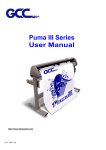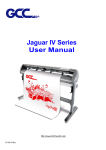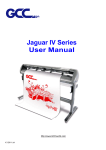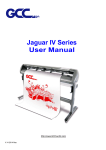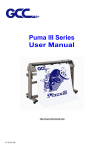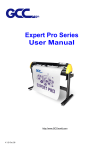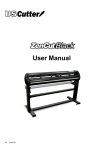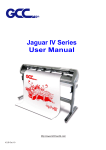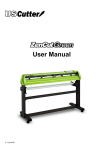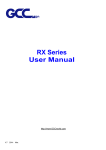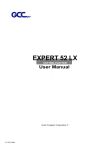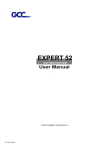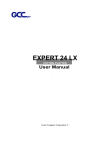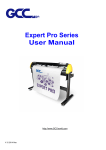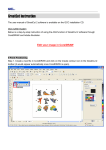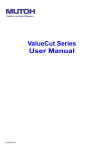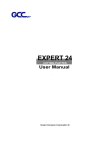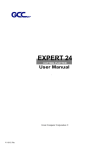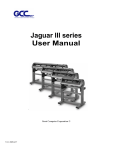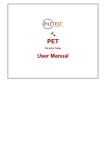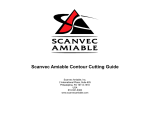Download Puma III Series User Manual
Transcript
Puma III Series
User Manual
http://www.GCCworld.com
V.6 2012 Feb.
NOTICE
GCC reserves the right to modify the information contained in this user
manual at any time without prior notice; un-authorized modification, copying
distribution or display is prohibited. All comments, queries or
suggestions concerning this manual please consult with your local dealer.
V.6 2012 Feb.
Puma III User Manual
IIm
mp
po
orrttaan
ntt IIn
nffo
orrm
maattiio
on
n
Thanks for your purchase of GCC Puma III Cutting Plotter. For your
safety and to optimize the performance of the Puma III, please read
the user manual completely and keep it in a correct location.
PRECAUTIONS IN USE
z For safety concern, please always hold the cutter firmly from the bottom
when moving it. Do not move the cutter by clasping the depression area on
both sides.
z Do not shake or drop the blade holder, a blade tip maybe fly out.
z During operation, keep away from any moving parts of the cutter (such as
the carriage, drums). Also be careful that your clothing and hairs do not be
caught.
z Always connect the power cable to a grounded outlet.
z Always use the accessory power cable that is provided. Do not wire the
power cable so that it becomes bent or caught between objects.
z Do not connect the power cable to branching outlet to which other
machines are also connected, or use an extension cable. There is danger
of overheating and of misoperation of the machine.
z Keep the tools away from children where they can reach.
z Always put the pinch rollers within position of the white marks.
Important Information
Puma III User Manual
Contents
Important Information
1. General Information
1.1
Introduction
1.2 Package Items
1.3
Product Features
1.4 Front View of Puma III
1.5 Back View of Puma III
1.6
The Whole View of Puma III
1.7
The Left-hand Side of Puma III
1.8
The Right-hand Side of Puma III
2. Installation
2.1
Precaution
2.2
Stand & Flexible Media Support System
2.2.1 Stand Installation (for P3-60)
2.2.2 Stand & Flexible Media Support System (for P3-132S)
2.3 Blade Installation
2.4
Cable Connections
2.4.1 USB Interface
2.4.2 Parallel Interface
2.4.3 RS-232 Interface
2.4.4 Data Transmitting
3. The Control Panel
3.1 The LCD Panel
3.2
Menu in On-line Mode
3.3
Menu in Off-line Mode
3.4
Menu Items
4. Operation
4.1
4.2
4.3
4.4
4.5
Media Loading
4.1.1 Loading the Sheet Media
4.1.2 Loading the Roll Media
Tracking Performance
Cutting Force and Offset Adjustment
When Completing the Cutting Job
Puma III Print Driver setting
4.5.1 Puma III Print Driver setting>Option Page
4.5.2 Puma III Print Driver setting>Paper Page
5. Accu-Aligning System
5.1
Introduction
5.2
Calibrating the System
5.2.1 Media Calibration
5.2.2 AAS Calibration
5.2.3 AAS II on Puma III
5.3
Printer Test
5.4
Contour Cutting
Contents
1-1
1-1
1-2
1-3
1-4
1-4
1-5
1-5
2-1
2-2
2-2
2-3
2-6
2-9
2-9
2-12
2-13
2-13
3-1
3-2
3-3
3-4
4-1
4-1
4-3
4-6
4-7
4-9
4-10
4-10
4-12
5-1
5-1
5-1
5-2
5-3
5-4
5-6
Puma III User Manual
5.5
Tips for AAS
5-8
6. Maintenance
6.1
Cleaning the cutting Plotter
6.2
Cleaning the Grid Drum
6.3
Cleaning the Pinch Rollers
6-1
6-2
6-2
7. Trouble Shooting
7.1
Non-Operational Problems
7.2
Operational Problems
7.3
Communication Problems
7.4 Software Problems
7.5
Cutting Quality Problems
7-1
7-2
7-3
7-4
7-5
Appendix
A-1
A-2
A-3
A-4
A-5
A-6
A-7
A-1
A-2
A-3
A-4
A-5
A-6
A-7
Contents
Specifications of Puma III
Blade Specification
CorelDRAW Plug-In Instruction
SignPal 8.5 Instruction
EasySIGN Instruction
GreatCut Instruction
Illustrator Plug-In Instruction
Puma III User Manual
Chapter 1 General Information
1.1
Introduction
Puma III series cutting plotters have been designed to produce computer-generated images
or perform contour cutting on sheets or rolls of vinyl media.
This manual covers the following models of Puma III series cutting plotters:
1.2
‧P3-60
for media width: 70mm(2.76”) ~ 719mm(28.3”)
‧P3-132S
for media width: 70mm(2.76”) ~ 1470mm(57.87”)
Package Items
The package of the Puma III model contents the items listed below, please check carefully.
If you find any item missing, please consult your local dealer for further assistance.
Standard Item
Quantity
1. Cutting Plotter
1
2. Stand Set ( for P3-132S only, optional for P3-60)
z 2 piece of T-shape stand
z 1 piece of stand beam
z 18 pieces of M6 screws
z 1 piece of M5 L-shape hexagon screw driver
z 1 piece of Installation Guide for Stand Set
1
3. Flexible Media Support System Package
Items
1 set of Roll Media Flange (2 pieces)
1 set of Roll Holder (2 pieces)
1 set of Roll Holder Guide Bushes (4 pieces)
P3-132S
V
V
V
1 set of Roll Holder Support (2 pieces)
32 pieces of M6 screws
1 piece of M6 L-shape hexagon screw driver
V
V
V
V
1 piece of Roll Base
General Information
P3-60
1-1
1
Puma III User Manual
4. Accessories
z 1 piece of User’s Compact Disk
z 1 piece of AC power Cord
z 1 pieces of data cable (RS-232C)
z 1 pieces of data cable (Print cable)
z 1 pieces of data cable (USB cable)
z 1 set of Blade Holder Assembly (Installed in tool carriage of the cutting
plotter )
z 1 piece of Blade (Installed in Blade Holder)
z 1 piece of Safe Blade
z 1 piece of Cutting Pad
z 1 piece of Tweezers
z 1 piece of Promise Card
1.3
Product Features
The following are the main features of the Puma III series cutting plotters:
‧
‧
‧
‧
‧
‧
Tri-port connectivity provides you with greater flexibility
Up to 400-gram cutting force
Up to 600mm/per second cutting speed
Guaranty 3-meter tracking
User-friendly, multi-language control panel
Enhanced Accu-Aligning System for automatic contour cutting
General Information
1-2
1
Puma III User Manual
1.4
1.4.1
Appearance of Puma III
The Front View (Figure 1-1)
Grid Drums
Tool Carriage
move the media back and
performs the
forth during operation.
Control Panel
cutting with the
Slicer Groove
14 buttons and 1
installed blade or
cuts off the extra
LED and 1 LCM
pen with AAS
media easily along
showing messages
module.
this groove.
and menus.
Cutting Pad
Platen
provides the protection of
provides the surface for
blade when the blade is
supporting media while
cutting.
cutting
Alignment Rulers
media can be aligned
with the clear guide line
marks
Figure 1-1
General Information
1-3
Puma III User Manual
1.4.2
The Back View (Figure 1-2)
Pinch Rollers
hold the media during cutting.
Lever
raises or lowers
the pinch rollers.
Figure 1-2
General Information
1-4
Puma III User Manual
1.4.3
The Whole View (Figure 1-3)
**Stand for Puma III 60 is an optional item.
**Stand for Puma III 132S is a standard item.
Roll Holder – holds
and supplies the roll
media for cutting.
Roll Holder Guide
Bushes – serve to
keep the roll media in
place when media is
pulled from the roll.
Roll Holder
Support – supports
roll holders.
T-Stand –supports
T-Stand –supports
the cutting plotter
the cutting plotter
Stand Beam –
stabilizes the body.
Figure 1-3
General Information
1-5
Puma III User Manual
1.4.4
The Left-hand Side (Figure 1-4)
Power Switch – On when switches to [I]; Off to [O]
Fuse – 3 Amp.
AC Power Connector
Figure 1-4
1.4.5
The Right-hand Side of Puma III (Figure 1-5)
Serial Interface Connector (RS232C)
used to connect the cutting plotter to a
computer through a serial interface cable.
Parallel Interface Connector
used to connect the cutting plotter to a
computer through a parallel interface cable
Figure 1-5
USB Connector
used to connect the cutting plotter to a
computer through a USB cable.
General Information
1-6
Puma III User Manual
Chapter 2 Installation
2.1
Precaution
Notice 1
Carefully handle the cutter to prevent any injuries.
Make sure the power switch is off before installing the cutting plotter.
Notice 2
A proper place for installation the cutting plotter
Please select a proper location that meets the following conditions.
The machine can be approached easily from any direction.
Keep at least 60 cm space in front and behind the machine.
Make sure the cutter is placed on a flat, level and sturdy surface
The operation temperature should be between 15 and 30℃ (60-86oF) in the
workshop.
Keep the relative humidity between 25% and 75% in the workshop.
Protecting the machine from dust and air current.
Preventing the machine from direct sunlight.
Notice 3
Connecting the Power Supply
Check the plug of the power cord to see if it matches the wall outlet. If not, please
contact your dealer.
Insert the plug (male) into a grounded power outlet.
Insert the other end (female) of power cord into the AC connector of cutting
plotter.
Installation
2-1
Puma III User Manual
2.2
Stand & Flexible Media Support System
2.2.1 Stand Installation(for P3-132)
Please follow procedure below to assemble stand and media support system.
Step 1 Please examine supplied items in the accessory box of stand carton
before you install:
Stand is a optional item for Puma III-60, Item List:
z
z
z
z
z
2 piece of T-shape stand
1 piece of stand beam
18 pieces of M6 screws
1 piece of M5 L-shape hexagon screw driver
1 piece of Installation Guide for Stand Set
Step 2
z
Remove the plotter body and the accessories from the shipped carton.
Place the stand beam upright on the T-stand and follow the number XY
to assemble.
(See Figure 2-1 & 2-2)
z
X T-Stand
Y Stand beam
Figure 2-1
Figure 2-2
Installation
2-2
Puma III User Manual
Step 3
Position the stand beam perpendicularly to part Xand put the screws into the
holes and tighten them as Figure 2-2. Then the complete picture of stand will be
like Figure 2-1.
Step 4
Remove the cutting plotter from the carton. Position your stand under the plotter,
and then insert the screws into the holes on plotter’s bottom and tighten them up
as shown in Figure 2-3.
Screws
Figure 2-3
Installation
2-3
Puma III User Manual
Step 5
Insert the roll holder support with the screws into the holes of the stand, and then
tighten them up as shown in Figure 2-4. You could decide roll holder support’s
position by inserting into different holes.
3 screws
Roll holder
Installation
2-4
Puma III User Manual
Step 6
Place two roll holders into the holes in the roll holder support. (Figure 2-5)
Roll holder support
Roll holders
Figure 2-5
Step 7
Lastly, the complete picture will be shown like below. (Figure 2-6)
Figure 2-6
Installation
2-5
Puma III User Manual
2.3
Blade Installation
! Caution
Do not touch the tip of the blade by your fingers.
! Notice
The blade is a consumable item, which will affect the cutting quality significantly.
Please replace with a new blade when having the following situations:
1. The tip of blade is broken.
2. The cutting traces are not as good as they were.
3. Uncut area remains the same even the blade force has been raised significantly.
Figure 2-11 is the picture of the blade holder. Insert a blade into the bottom of the
blade holder. Pushing the pin on the top of blade holder can remove the blade.
Be sure to keep your fingers away from the blade tip.
Pin
Adjustment depth knob
Outward ring
Figure 2-11
Installation
2-6
Puma III User Manual
1. Install Blade. (Figure 2-12)
Figure 2-12
2. Push the blade to the bottom of the blade holder. (Figure 2-13)
Figure 2-13
3. Adjust the blade tip to suitable length by rotating “Blade tip adjustment screw”
clockwise or counterclockwise. (Figure 2-14)
Tips:
“The proper length” means
the blade length is about
0.1mm more than film’s
thickness. For example, if
the thickness of film is
0.5mm, then the blade
length is properly adjusted
to 0.6mm and it can
completely cut through the
film layer without cutting
though the paper backing.
Figure 2-14
Installation
2-7
Puma III User Manual
4. Insert the blade holder into tool carriage. Please note the outward ring of the
holder must put into the groove of carriage firmly (Figure 2-15) and lock the grip.
(Figure 2-16)
Figure 2-15
Figure 2-16
5. Reverse steps mentioned above to remove the blade holder.
6. Press the push-pin to remove the blade from the blade holder when replacing
blade. (Figure 2-17)
Figure 2-17
Installation
2-8
Puma III User Manual
2.4 Automatic Blade Length Adjustment
Figure 2.-18 is the new blade holder with a scale and the carriage with a mark.
Scale
Mark
Figure 2-18
Figure 2-19
There are 10 units on the scale; each unit equals to 0.1 mm, allowing you to adjust the
blade length for 0.00mm-5.00mm (Figure 2-18).
Follow the steps below to adjust the length of the blade
1. Keep your blade length as 0 before you start adjusting.
2. Align one of the scales on the blade holder to the mark on the carriage
3. Select “Blade Length Adjust” under “CUT TEST” on the LCM, enter the blade
length wished in “Set Length”; test the blade holder first and then test the
blade length by pressing ENTER.
Note: Keep the blade holder at the same position when you perform blade holder
and blade length tests.
4. When blade holder and blade length tests are finished, the screen will show
you to what degree (the unit of the value following “CW” or “CCW” is “circle”)
and in which direction [CW (clockwise) or CCW (counterclockwise)] you
should turn the adjustment knob.
EG, Turn CW 0.5 is telling you that you should turn the knob for half a circle
clock-wisely (Figure 2-20, Figure 2-21).
Installation
2-9
Puma III User Manual
The value on the screen will be 0.0 when the blade length is perfect and no more
adjustment needs to be made. You may start cutting at this point.
Figure 2-20
Installation
Figure 2-21
2-10
Puma III User Manual
2.5
Cable Connections
Puma III communicates with a computer through USB (Universal Serial Bus),
Parallel port (Centronics) or Serial port (RS-232C). This chapter shows you
how to connect the cutting plotter to a host computer and how to set up the
computer/cutting plotter interconnection.
!! Notice: When USB connection is enabled, both parallel port and serial port will
be disabled automatically.
Parallel port
USB port
Serial port
Figure 2-22
2.5.1
USB Interface
Puma III build-in USB interface is based on the Universal Serial Bus
Specifications Revision 1.1. USB is not available in Windows 95, Windows NT.
USB driver installation
Caution!!
9 If you are using Windows 2000 / XP / Vista / 7 as your
operating system, make sure you log in using the
“Administrator” account.
Use the USB One-click Installation for quick driver installation. Follow the
simple steps below for driver setup.
Installation
2-11
Puma III User Manual
Step 1:
Connecting your GCC cutter
1. Turn on the machine.
2. Connect the USB connector to the machine and then USB driver will
installed automatically. It will take a few minutes to find the device.
Please DO NOT disconnect the USB cable until the installation has
completed.
3. You can double click the USB icon on the taskbar to make sure the USB
device is detected.
Step 2: Installing the software
(1) Put the installation CD into your CD-ROM. Please make sure that the
USB device is connected before you start the driver installation.
(2) Choose the model you want to install from the driver list and click on
either the 32 bit or 64 bit driver installation depending on the operating
system installed on your computer to start the installation. (The Expert
Pro model is used as an illustration in the following steps.)
Installation
2-12
Puma III User Manual
(3) Click “Next” to start the driver installation.
(4) The installation will take a few minutes to complete and you will see a
message below and click on “OK” upon completion. Enjoy your GCC
cutter!
Installation
2-13
Puma III User Manual
Note:
(1) If the driver is being installed for a second time, the user will be prompted as
to whether a second copy of the driver installation is required.
(2) If the user selects yes, a second copy of the driver will be installed.
2.5.2
z
Parallel Interface
Connecting to the Parallel (Centronics) Port
1. Connect a parallel cable to the cutting plotter and the host computer
2. Set up the output port LPT1 or LPT2 from your software package
3. Send the data to your cutting plotter directly. Or, use DOS commands like
TYPE or PRINT to output data.
Caution!! Please turn off the plotter before plugging the print cable.
Installation
2-14
Puma III User Manual
2.4.3 RS-232 Interface
Connecting to the RS-232 (Serial) Port
1. For Personal Computer users, connect the RS-232C cable to the serial
connector of the assigned serial port (COM1 or COM2) on your host
computer.
2. Set up the communication parameters (Baud Rate and Data Bits/Parity) to
match the setting of software package, refer to chapter 3 – “MISC” key
description.
Caution!! Please turn off the plotter before plugging the RS-232C cable.
2.4.4 Data Transmitting
There are two options to transmit the data from the computer to the cutting
plotter:
Option 1
With proper interface settings, the data can be transmitted from your application
software package to the cutting plotters directly.
Option 2
Most cutting software packages are able to emulate HP-GL or HP-GL/2
commands. As long as the file is HP-GL or HP-GL/2 format, the cutting plotter
can output the data precisely.
Installation
2-15
Puma III User Manual
Chapter 3 The Control Panel
This chapter describes the button operations with the LCM menu flowcharts of Puma III. When
the cutting plotter is ready for use as described in Chapter 1 & 2, all functions are under default
parameters.
3.1
The LCD Panel
< LCD Control Panel on Puma III series >
Key
Function
LCD Screen
To display functions and error messages.
Power LED
To indicate the power status ( light up: power on; light off: power off )
4 Arrow Keys
To move position, select function, or change setting.
ENTER
To set item or register the immediately preceding input value.
PAUSE/RESUME
To temporarily halt cutting process or to continue
ON/OFF LINE
To switch modes, stop cutting job, or abort changes of settings.
OFFSET
To adjust the value of blade’s offset.
FORCE
To adjust the value of cutting force.
SPEED
To adjust the value of cutting speed and quality.
CUT TEST
To perform cutting tests in different ways.
DATA CLEAR
To clear up buffer memory.
TOOL SELECT
To select tools.
MISC
To set up functions.
Please see details in “3.4 Menu Items”
The Control Panel
3-1
Puma III User Manual
3.2
Menu in On-line Mode
Power On
Puma III in processing
GCC Cutter
LCM Version- - -
Puma III
Firmware:
Copyright:
Place Media And Then Lower
Down The Lever
Roll
Edge
Single
use
to select
Sizing Media Width Lever Up
To Abort
Sizing Media Length Lever Up
To Abort
Top menu
S--- F----- O---L-------- W-----T1M
Sending data
[PAUSE ]
Pause
Setup
Resume
[ FORCE]
Force:80 gf
OK:ENTER
[ SPEED ]
[ OFFSET ]
Offset: 0.275 mm
OK:ENTER
[ DATA CLEAR ]
Clear Data Memory
N:Cancel
OK:ENTER
[TOOL SELECT ]
1S:51
Select:
F:80
O:0.275 M
OK:ENTER
Set Smoothing Cut
Select:
OverCut:
Select:
OK:ENTER
0.00mm
OK:ENTER
Set Tangential Mode
Select:
The Control Panel
3-2
OK:ENTER
use
to select; [ENTER] to enable the setting
Speed:
51cm/s
Select:
OK:ENTER
UP Speed:
Select:
51 cm/s
OK:ENTER
Quality:
Select:
Fine
OK:ENTER
Puma III User Manual
3.3
Menu in Off-line Mode
Press [ON/OFF LINE] to switch to the offline mode
Offline For
System Setup
[ FORCE]
Force: 80 gf
OK:ENTER
5~400 with an increment of 5(gram force)
[ OFFSET ]
Offset: 0.275 mm
OK:ENTER
0.000~1.000 with an increment of 0.025(mm)
[ DATA CLEAR ] Clear Data Memory
N:Cancel
[
]
[ SPEED ]
OK:ENTER
move origin
Y:
X:
Speed:
Select:
51 cm/s
OK:ENTER
Speed:3~60 with an increment of 3(cm/s)
UP Speed:
Select:
51 cm/s
OK:ENTER
UP Speed:3~60 with an increment of 3(cm/s)
Quality:
Select:
Fine
OK:ENTER
Draft, Normal, Fair, Fine
[CUT TEST ]
Square Cut
Select:
OK:ENTER
Repeat AAS Job
Select:
OK:ENTER
Repeat Last Plot
Select:
OK:ENTER
Pattern Setting
Select:
OK:ENTER
Ratio Setting
Select:
Pattern: Arrow
Change:
OK: ENTER
Pattern: Cross, Arrow
Ratio:
Change:
Ratio: 100%, 200%, 300%, 400%
100%
OK: ENTER
Test Blade Holder
OK: ENTER
OK:ENTER
Blade Length Adjust
Select:
OK:ENTER
Set Length
Change:
0.00mm
OK: ENTER
Test Blade Length
OK: ENTER
Turn CW , Turn CCW
The Control Panel
3-3
Puma III User Manual
Offline For
System Setup
1S:51
Select:
F:80
O:0.275 M
OK:ENTER
Set Smoothing Cut
Select:
OK:ENTER
OverCut:
Select:
[TOOL SELECT ]
OverCut:0.00-1.00mm with an
increment of 0.05mm
0.00mm
OK:ENTER
Set Tangential Mode
Select:
OK:ENTER
Panel Setup
Select:
OK:ENTER
Restore default ?
Select:
OK:ENTER
Save parameter ?
Select:
OK:ENTER
Firmware: x.x.xx
FPGA:Vx.x
mm/dd/yy
Vacuum
Select:
OK:ENTER
AAS Offset
Select:
OK:ENTER
Auto Unrolled Media
Select:
OK:ENTER
[ MISC ]
Media Back & Forth
Select:
OK:ENTER
Paper Saving Mode
Select:
OK:ENTER
Both Expanded Mode、Length Expanded Mode、
Width Expanded Mode、Both Unexpanded Mode
Set Communication
Select:
OK:ENTER
Select Language
Select:
OK:ENTER
English,Spanish,Italian,Deutsch,Japanese,Portugue
se,Polish,Turkish,French
Select Unit
Select:
Metric (cm/gf) or English
measurement (inch/oz)
OK:ENTER
Scale Length
Select:
OK:ENTER
Scale Width
Select:
OK:ENTER
GCC USB Mode
USB Printer Type
Select:
OK:ENTER
The Control Panel
Common USB Mode
3-4
Puma III User Manual
3.4
Menu Items
Below describes the functions of menu items
Menu or Key
Function
Setting
Default
--- Media sizing --Roll
To measure media width.
Edge
To measure media width and pull the media back till the front Maximum Tracking
150 meters
paper sensor open.
To measure media width and length.
Maximum Tracking
Single
Maximum Tracking
150 meters
10 meters
--- POWER --To indicate the power status.
[ Arrow Keys ]
1. To move the tool carriage position on X or Y axis.
2. To select functions or change values of settings.
[ ENTER ]
1. The displayed parameters will be saved automatically.
2. To set a new origin at the present tool carriage position.
In “offline” mode, moving the tool carriage to desired
position by [Arrow Keys], then press [ENTER] key to set a
new origin. While moving with the parameters of XY-axes
displayed, press [MISC] key will enable fine-tune
movement; press [MISC] key again to disable the function.
[ PAUSE/RESUME ]
To temporarily halt the cutting process.
To resume the process by press [Pause/Resume] key again.
[ ONLINE/OFFLINE ]
1. To switch between online mode and offline mode.
2. To stop the cutting job or abort the change of setting.
Once press this key, the cutting job will be terminated
immediately and cannot be resumed.
[ OFFSET ]
To set or modify the distance between the blade tip and the
center axis.
[ FORCE ]
To set or modify the value of tool force.
Speed
[ SPEED ]
To set or modify tool speed at horizontal moving.
Up Speed
To set or modify tool speed at vertical moving.
Cutting Quality To set or modify cutting quality.
[Slower speeds / higher quality - Faster speeds / lower quality]
The Set Cutting Quality Page allows you to adjust and
balance vector mode’s quality and speed settings based on
your specific job. Draft Mode offers the highest output speed,
sacrificing quality. Whereas Quality Mode offers the highest
quality, sacrificing output speed. Keep in mind that speed and
quality are usually at a tradeoff.
[ CUT TEST ]
The Control Panel
3-5
0.000~1.000mm 0.275mm
5~400gram;
5 gram/per step
80 gram
3~60cm/sec;
51cm/sec
3cm/sec per step
3~60cm/sec;
51cm/sec
3cm/sec per step
Draft, Normal,
Normal
Fair, Fine
Puma III User Manual
Square Cut
Repeat AAS
Job
Repeat Last
Plot
To perform a cutting test at present blade position.
For more information, please refer to “4.3 Adjusting the
Cutting Force and Offset” to adjust blade force and cutting
speed.
To repeat AAS jobs automatically without having to operate
on the computer side.
Please be noted that this feature is mainly applied to the
Single paper mode; please ensure a new piece of material
you wish to apply this feature on is loaded and the origin
repositioned to the first registration mark before starting.
When the first AAS job repeat completes, the user will be
offered the choice of “Repeat AAS Job Again”, please
press ”Online/Offline” to return to the main menu.
Recut:
To repeat the last job without re-sending the data.
1~99;
1 per step
Copy:
To copy the last job without re-sending the data.
1~99;
1 per step
* 1mm gap will be auto-generated between 2 copies).
* If the media length is not enough to continue, it will show
below message on LCM:
Ou t O f S p a c e ;
#
o f Co p i e s f i n i s h e d
If both functions are enabled at the same time, the cutter will
perform the last setting only.
Pattern Setting To provide two patterns for cut test
“Arrow” and
“Arrow”
Note: It is recommended to select “Cross” if you are working “Cross” patterns
on thick pieces of materials.
Ratio Setting
To adjust the size of the pattern
Blade Length
Adjust
To adjust the length of the blade
Note:
1. Keep your blade length as 0 before you start adjusting.
2. Test the blade holder first and then test the blade length by
pressing ENTER.
3. Keep the blade holder at the same position when you
perform blade holder and blade length tests.
4. When blade holder and blade length tests are finished, the
screen will show you to what degree (the unit of the value
following “CW” or “CCW” is “circle”) and in which direction
[CW (clockwise) or CCW (counterclockwise)] you should
turn the adjustment knob.
EG, Turn CW 0.5 is telling you that you should turn the
knob for half a circle clockwisely.
5. The value on the screen will be 0.0 when the blade length
is perfect and no more adjustment needs to be made. You
may start cutting at this point.
[ DATA CLEAR ]
To clear up buffer memory.
Set Smoothing
Cut
Over Cut
The Control Panel
[ TOOL SELECT ]
To enable smooth-cutting function.
To generate an overcut to facilitate weeding.
3-6
100%, 200%,
100%
300%, 400%
0.00mm-5.00mm 0.00mm
Enable
0.00mm-1.00mm 0.00mm
0.05mm/per step
Puma III User Manual
Set Tangential
Mode
To enable the emulated tangential-cutting mode for thicker
media types and small letter cuts.
Note: while the Offset value setting at 0.000 mm, “Set
Tangential Mode” will automatically be disabled.
Panel Setup
Accept setup command:
To accept commands of the Force, Speed, Cutting Quality,
and Offset only via software.
Disable
Control panel only:
To accept commands of the Force, Speed, Cutting Quality,
and Offset only via control panel of the cutter.
Restore
Default
To turn all parameters of the menu items to factory-default
settings.
Save
Parameter
To save pattern(s) of cutting parameters for later use.
Auto Unrolled
Media
[ MISC ]
To avoid paper jam and motor crash by automatically unroll
media (50cm and up) before cutting while enabled. .
* Auto-unroll only effects on roll/edge media.
* Using Single mode to size media will disable this function
automatically.
* If the length of the rolled media is less than 2 meters or the
weight is light, it is recommended to set this mode disabled.
Vacuum
To help improve tracking and cutting accuracy by turning on
the fans. If you turn off the vacuum system, the fans
will remain inactive during cutting or plotting.
AAS Offset
To set or modify AAS offset value.
You can refer to “5.3 Printer Test” for more details.
To enable to save time on repeated cutting jobs and better
tracking.
After cutting job has finished, the media will move back to the
origin, then move to the end of the plot.
Media Back
& Forth
Paper Saving
Mode
Set
Communication
Firmware
Version
The Control Panel
To save media by four different modes:
1. Length expanded mode 2. Width expanded mode
3. Both expanded mode
4. Both unexpanded mode
To build up the communication between host computer and
cutter.
Baud Rate is to determine the speed of data transmission.
Data Bits refers to the size of one block of data.
Parity is used to check if data was revived correctly or not.
9600, n, 7, 1, p
9600pbs, 7 Bits with NO Parity
9600, o, 7, 1, p
9600pbs, 7 Bits with ODD Parity
9600, e, 7, 1, p
9600pbs, 7 Bits with EVEN Parity
9600, n, 8, 1, p
9600pbs, 8 Bits with NO Parity
9600, o, 8, 1, p
9600pbs, 8 Bits with ODD Parity
9600, e, 8, 1, p
9600pbs, 8 Bits with EVEN Parity
19200, n, 7, 1, p
19200pbs, 7 Bits with NO Parity
19200, o, 7, 1, p
19200pbs, 7 Bits with ODD Parity
19200, e, 7, 1, p
19200pbs, 7 Bits with EVEN Parity
19200, n, 8, 1, p
19200pbs, 8 Bits with NO Parity
19200, o, 8, 1, p
19200pbs, 8 Bits with ODD Parity
19200, e, 8, 1, p
19200pbs, 8 Bits with EVEN Parity
To display the version number of Firmware and FPGA code.
3-7
Disable
Enable
Disable
Both
unexpanded
mode
Puma III User Manual
Select
Language
To select displayed languages on LCM panel in English,
Spanish, Italian, Deutsch, Japanese, Portuguese, Polish,
Turkish or French.
Select Units
Provide two-unit systems for users convenient.
Scale Length
To adjust the scale of media length and width that may cause
by the thickness of the media.
English
cm/gram;
inch/oz
Metric
The Denominator is the actual length, and the Numerator is
the ideal length measured from the resultant.
Scale Width
USB Printer
Type
For example, cutting a line with 500.0 mm length. The
procedure as follows:
1. Press the [LEFT ARROW] to choose the Numerator and
select 500.0 mm,
2. Cut the length by sending a graph file,
3. Measure the length then use the [RIGHT ARROW] key to
choose the Denominator, then
4. Press [UP ARROW /DOWN ARROW] to change the values
of the actual length.
To select USB Mode from the LCM panel. Two USB modes
are available: GCC USB Mode and Common USB Mode.
GCC USB Mode: For 32 bit driver
[Windows XP/2000/ 7 /Vista]
Common USB Mode: Both for 32 bit & 64 bit driver
[Windows XP/7/Vista]
The Control Panel
3-8
Common
USB Mode
Puma III User Manual
Chapter 4 Operation
4.1
Media Loading
4.1.1 Loading the Sheet Media
To load the media properly, please follow the procedures listed below:
Pull the lever upward to raise the pinch rollers. (Figure 4-1)
Figure 4-1
Load your media on the platen and slide it under the pinch rollers from either the front side or
the backside. The alignment rulers on the platen extension will help you to adjust the media
precisely.
Note:
Be sure that the media must be covered by the paper sensors on the
platen when loading the media. At least one of the two paper sensors
should be covered. Once the media covers the sensor, the cutting plotter
will size width and length of media automatically.
Then move the pinch rollers manually to the proper position. Be sure the pinch rollers must be
positioned above the grid drum. The white marks on top trail will help you position pinch rollers
when media on the platen. (Figure 4-2)
Operation
4-1
Puma III User Manual
White Marks
Figure 4-2
Push the lever downward to lower down the pinch rollers.
Turn on the power; the machine will be initialized. Then follow the instruction of LCM to measure
the size of the media.
Note:
Move the pinch roller by applying force at the rear portion of the pinch roller support. Do not
move it by holding its front rubber roller.
Figure 4-3 correct way to move pinch rollers
Operation
4-2
Puma III User Manual
4.1.2
Loading the Roll Media
Firstly, put the roll media guide bushes on two roll holders. (Figure 4-4)
Figure 4-4
Option A
Insert the two roll holders into the roll media support set, and then place the roll media directly
between the two roll holders. (Figure 4-5)
Figure 4-5
Operation
4-3
Puma III User Manual
Option B (Use the media flange)
1. Insert a roll media flange at the end of each roll media and tighten the thumbscrew until the
roll media is firmly gripped. (Figure 4-6)
Figure 4-6
2. Then put the roll media on the roll holders. Adjust the position of the roll media ensure that
the media flange is able to run in the groove of media guide bushes. (Figure 4-7)
Figure 4-7
Operation
4-4
Puma III User Manual
3. Loading the media on the platen. After loading the roll media, flatten the media on the platen
and hold the front edge of the roll media firmly.(Figure 4-8)
Figure 4-8
4. Then turn the roll downward to make an equal tension across the media. (Figure 4-9)
Figure 4-9
5. Move the pinch rollers to the precise location and be careful that the pinch rollers must be
positioned above the grid drums.
6. Push the lever downward to lower down the pinch rollers.
7. Fixes roll media guide bushes on the roll holder to secure the roll media.
8. Turn on the power switch, and the tool carriage will size the media automatically. Then the
cutting plotter is ready to work.
Operation
4-5
Puma III User Manual
9. Unloading media:Reversing steps mentioned above to remove the media.
For the users of Puma III-60, you can also use the “Roll Base” (a standard accessory of Puma
III-60) to feed a roll media. Please adjust the position of roll base to get a good cutting result.
(Figure 4-10)
Figure 4-10
4.2
Tracking Performance
In order to achieve the best tracking performance for a long plot, please leave the margin of
0.5mm~25mm in the left and right edges of the media.(Figure 4-11)
0.5mm-25mm
0.5mm-25mmm
Pinch roller
Operation
Figure 4-11
4-6
Pinch roller
Puma III User Manual
4.3
Cutting Force and Offset Adjustment
Before sending your designs from computer to Puma III for cutting, please make “Cut Test” to
adjust cutting force and offset value.
The “Cut Test” should be repeated several times until the optimum settings are achieved.
Please follow procedure below to optimum the cutting force and offset settings.
Step1.
After sizing the media, press [CUT TEST] button to select the “Square Cut”, and press [ENTER
KEY] to confirm.
The default cutting force and offset value of the cutting test are 80gf and 0.275mm respectively.
Step2.
Press [ARROW KEY] to move the tool carriage to the position where you would like to cut. Then,
press the [ENTER KEY] to make a “Cut Test”.
Note: At the same time, the new origin is also set at the cut test position.
Step3.
When the “Cut Test” is completed, a pattern appears (please refer to Figure 4-12). Peel off the
pattern to see if it can be easily separated from the media base. If the output result is good, the
cutting force is set appropriately. If not or it cut through the back paper of media, press [FORCE
KEY] to adjust the tool force until an optimum force is obtained.
Step4.
If the pattern appears to be BB or CC layout (see Figure 4-12), press [OFFSET KEY] to adjust
the offset value until AA pattern is shown.
Operation
4-7
Puma III User Manual
S q u a r e
C u t
S e l e c t :
Mo v e
X :
AA
OK : E n t e r
Press
ENTER_KEY
c u t
t e s t
M
Y :
Press
ENTER_KEY
BB
C o n t i n o u s
N : C A N C E L
CC
S q u a r e
C u t
OK : E n t e r
Press
ENTER_KEY
Press SPEED_KEY,
FORCE_KEY,
OFFSET_KEY to
setup
or
Press arrow keys to
desired position for
next square cut
Press
ENTER_KEY
Finish square cut
Press
CANCEL_KEY
3mm
3mm
80 mm
80 mm
80 mm
Machine
Figure 4-12
Operation
4-8
Puma III User Manual
4.4
When Completing the Cutting Job
After completing the cutting job, raise the sheet-loading lever, and then remove the material.
You can also cut off the finished job by the Safe Blade (a standard accessory) along the knife
guide. (Figure 4-13)
Figure 4-13
Operation
4-9
Puma III User Manual
4.5 Puma III Print Driver setting
4.5.1 Puma III Print Driver setting>Option Page
Die Cut
The Die Cut function must be activated with the Kiss Cut function to avoid the falling of
cut-through materials and material jam beneath the carriage. Die Cut helps you to cut through
the backing of the material while Kiss Cut cuts through only the top layer but not the backing.
This will leave only tiny bits of the backing attached to the top layer, creating complete individual
patterns with backing sheets (see figure 1 and 2).
Vinyl
Cutting line
Figure 1
Figure 2
Operation
4-10
Puma III User Manual
To activate the Die Cut function, go to “Option”, tick “Die Cut”, and enter the amount you wish
for the “Length” and “Force” of both Die Cut and Kiss Cut, then click “OK” (see figure 3).
*Note:
The length setting for the
cutting line of Die Cut is in the
range of 0-2000mm whereas
that of Kiss Cut is 0-100mm.
Figure 3
When the job is completed and you untick the Die Cut function, you will be able to adjust the
pen speed, pen force, and offset in the section on the top following normal operating procedures
(see figure 4).
Note: the extension of the blade
has to be set to cut through
both the top layer and the
backing in the very beginning.
You then adjust the tool force
for the best cutting
performance.
Figure 4
Operation
4-11
Puma III User Manual
4.5.2 Puma III Print Driver setting>Paper Page
Connecting Multiple Cutters to one PC
This function allows your computer to recognize the cutter you wish to perform your job on from
other cutters with the same model name and printers connected at the same time, eliminating its
confusion when you send your image to the cutter.
To activate this function, go to “Paper” and tick “Connecting Multiple Cutters to one PC” (see
figure 1). Please do not tick this box if only one cutting plotter is in use.
Figure 1
When you are prompted to this window below, change your port setting manually.
Figure 2
Operation
4-12
Puma III User Manual
To do this, please go to “Printers and Faxes”, right click on the model you would like to work on
and click on “Properties”.
Go to “Ports” and tick the corresponding USB port (see figure 3). When this is completed, apply
the same steps to other cutters you would like to work on (see figure 4). Please make sure you
connect each cutter back to the same corresponding USB port every time.
Figure 3
Figure 4
Operation
4-13
Puma III User Manual
Chapter 5 Accu-Aligning System
5.1
Introduction
The Puma III series cutting plotters feature a standard Accu-Aligning System (AAS II) to
guarantee precise contour cutting quality by detecting the registration marks printed around the
graphic.
Notice
Avoid any kind of light source horizontally illuminating the AAS module.
- PROHIBITED
- ACCEPTABLE
DO NOT take off the cover of AAS module while in operation.
- PROHIBITED
Accu-Aligning System
5-1
Puma III User Manual
5.2
AAS Calibrating the System
The AAS system has one calibration procedures to ensure maximum accuracy of AAS
operation. To operate the AAS you need to learn about the method of media feeding firstly.
(Refer to 4.1 Media Loading.)
5.2.1 Media Calibration
Media Calibration is to ensure the sensor being able to recognize the registration marks.
The factory default works on a wide range of materials. However, certain types of
materials may not work properly. Performing a media calibration may become necessary
while working with such materials to change the sensitivity of AAS for greater reliability.
Media calibration adjusts the media feeding according to media type for better accuracy
during cutting.
When to use
We suggest white media for best cutting result. It is not necessary to perform media
calibration every time unless the registration marks on the printed media become
undetectable in AAS sensing process.
5.2.2 AAS Calibration
The first registration mark is designed to be different in order to identify the origin for AAS
auto-detection. The following precaution must be aware for registration marks to be read
automatically.
Type of media
Registration mark pattern
Reading range required for detection the registration marks
Position for registration marks and medium
The registration marks have to be:
Created by cutting software like SignPal or GCC CorelDRAW plug-in
In black color
“L” Mark Length: 10mm~50mm, suggested 25 mm
“L” Mark Thickness: 1mm~2mm, suggested 1 mm
Margin: 1mm~50mm, suggested 5 mm
The cutter can not detect the marks while:
Cutter carriage is not located near the outside area of first mark before
detecting (See the picture in page 5-7 for auto-detecting area of first mark.)
Medium thickness is more than 0.8mm
Transparent medium is used
Accu-Aligning System
5-2
Puma III User Manual
Non-monochrome drawing. The marks can’t be read if is printed on colored
medium
Dirty or creased medium surface
5.2.3 AAS II on Puma III
There are three types of AAS II mark patterns: 4-Point Positioning, Segmental Positioning, and
Multiple Copies. Note that before print out your designs by inkjet printers, the registration marks
have to be created on your graphic designs by cutting software like SignPal, EasySign or GCC
CorelDraw plug-in. Hand-made marks or drawings won’t be reorganized by GCC cutting
plotters. For more details about registration mark setting in cutting software, please refer to
‘Appendix A-3 : CorelDraw Plug-In Instruction”, ‘Appendix A-4 : SignPal 8.5 Instruction’,
‘Appendix A-5 : EasySIGN Instruction’ and ‘Appendix A-6 : GreatCut Instruction’
1. 4-Point Positioning
This is the basic mark pattern that AAS II will auto detect four registration marks and contour
cut images inside those marks.
Command: Esc.D1;(XDist);(YDist):
Layout: 4 L-shaped marks at the 4 corners around the design
2. Segmental Positioning
In addition to 4 original points, the intermediate registration marks are added on both X axis
and Y axis to help contour cut accurately, especially for cutting large images.
Command: Esc.D2;(XDist);(YDist);(XStep);(YStep):
Layout:
In-between distance on X: 200~600mm, default 300mm
In-between distance on Y: 200-600mm, default 300mm
Accu-Aligning System
5-3
Puma III User Manual
3. Multiple Copies
The function is used to duplicate images to let you cut quantities of images at a time.The
AAS II sensor will automatically scan registration marks for each individual image to ensure
the contour cutting precision.
Command: Esc.D3;(XCopies);(YCopies);(Space):
Layout:
Condition 1 (Default)
5.3
Condition 2
Printer Test
Before performing AAS contour cutting, it’s recommended to print out a test file that you
can find in the enclosed Installation CD to make sure the AAS II cutting accuracy of
Puma III.
There are two testing files for AASII:
1. AAS II_X_Y_Offset_Caberation_A4 .eps (A4 size)
2. AAS II_X_Y_Offset_Caberation_600_600 .eps (Default setting, it is recommended
for testing)
Print out the testing graphic. ( Please use high precision printer)
Load the graphic to Puma IIIand sent the file to test the cutting job
If there is any adjustments had to be made, you can change the offset value by
following the steps:
* Measure the offset values from the printed line and the actual cutting line.
* Enter the AAS Offset under MISC function for the values you just measured,
then press Enter
* Test the cutting again
Accu-Aligning System
5-4
Puma III User Manual
* AAS II offset X and Y value is defined as following:
Horizontal line is defined as X and vertical is defined as Y
* When the actual cutting line and the printed line need to be changed
towards the direction of origin mark, then simply add the negative value of
the offset. If the direction is from the opposite of the origin mark, then enter
positive values for the offset. This method apply on both X and Y axle.
For example:
If the values set in cutter is X: 0.50 mm Y 0.50 mm and the measurement is
X1:-0.25 mm Y 1:+0.25 mm. (In following figure, the Blue Line refers to the Y Value,
and the Red Line refers toe the X value.)
We need to adjust AASII offset X new : (X + X1) Y new : (Y + Y1) which means X
new : 0.25 mm Y new : 0.75, then save the set new value to cutter.
Note:
Before adjusting the AAS II settings, please proceed scaling for width and length.
The blade offset value isn’t set for this test graphic, please set it according to the
blade you use.
If you have any question, please contact us or your local distributor for assistance.
Accu-Aligning System
5-5
Puma III User Manual
5.4
Contour Cutting
For accurate contour cutting with AAS function, please proceed the following steps:
Step 1
Creating Graphics
■ Create the graphic that you want to print and cut in your software.
■ Create a contour for cutting around the graphic.
TIPS1: Leave some space between the graphic and contour line.
TIPS2: Create the contour in a separate layer and assign a different color for it.
■ Add registration marks around the graphic.
Note:
The Multiple Copies function is also available. It automatically copy the graphic and
registration marks.
Accu-Aligning System
5-6
Puma III User Manual
Step 2
Placing the Registration Marks
The AAS Layout Instruction:
* Auto-detection function on the 1st mark covers the grey area
Suggested 30mm margin on both left and right sides of media sheet.
Suggested 20~30mm margin on top of media sheet, and at least 50mm margin on
the bottom edge to prevent sheets dropping or any error occurred while media sizing.
Step 3
Print the Graphics
■ Print the graphic and the marks with your printer
(Scaling = 100%).
Accu-Aligning System
5-7
Puma III User Manual
■ When printing on a roll media, make sure the orientation as following:
Step 4
Load the printout onto cutter
■ The Origin Mark is is different from the rest registration marks. Please make sure the
media is fed with correct direction.
Step 5
Cut the Contour
■ Send out the command from software to perform the contour cutting job.
5.5
Tips for AAS
For getting better results of contour cutting, there are some tips below for your reference.
Keep light sources simple and avoid illuminating from the sides of cutter.
Before operating AAS, change the maximum paper size in Puma IIIdriver property.
STEP 1 Find the Puma III model in the “Printer & Fax” folder of your PC.
STEP 2 Open the Properties window and select the “Paper” tab.
STEP 3 Change the maximum Paper Size of X to 1200mm.
Adjust the cutting speed to between 300~600mm/sec.
Avoid the registration marks locating on the tracks of pinch rollers.
Accu-Aligning System
5-8
Puma III User Manual
Chapter 6 B
Baassiicc M
Maaiin
ntteen
naan
nccee
This chapter explains the basic maintenance (i.e. cleaning the cutting plotter)
required for the cutting plotter. Except for the below mentioned, all other
maintenance must be performed by a qualified service technician.
6.1
Cleaning the Cutting Plotter
In order to keep the cutting plotter under good condition and best performance,
you need to clean the machine properly and regularly.
Precaution in Cleaning
Unplug the cutting plotter before cleaning
Never use solvents, abrasive cleaners or strong
detergents for cleaning. They may damage the surface of
the cutting plotter and the moving parts.
Recommended Methods
Gently wipe the cutting plotter surface with a lint-free cloth. If necessary,
clean with a damp cloth or an alcohol-immersed cloth. Wipe with water to
rinse off any residue and dry with a soft, lint-free cloth.
Wipe all dust and dirt from the tool carriage rails.
Use a vacuum cleaner to empty any accumulated dirt and media residue
beneath the pinch roller housing.
Clean the platen, paper sensors and pinch rollers with a damp cloth or an
alcohol-immersed cloth, and dry with a soft, lint-free cloth.
Wipe dust and dirt from the stand.
Basic Maintenance
6-1
Puma III User Manual
6.2
Cleaning the Grid Drum
Turn off the cutting plotter, and move the tool carriage away from the area
needed to be cleaned.
Raise the pinch rollers and move them away from the grid drum for
cleaning.
Use a bristle brush (a toothbrush is acceptable) to remove dust from the
drum surface. Rotate the drum manually while cleaning. Refer to Figure 6-1
Figure 6-1
6.3
Cleaning the Pinch Rollers
If the pinch rollers need a thorough cleaning, use a lint-free cloth or cotton
swab to wipe away the accumulated dust from the rubber portion of the pinch
rollers. To prevent the pinch rollers from rotating while cleaning, use finger to
hold the pinch rollers not to rotate.
If needed to remove the embedded or persistent dust, use the lint-free cloth or
cotton swab moistened with rubbing alcohol.
Note: The daily maintenance of your cutting plotter is very important.
Be sure to clean up the grid drum and pinch rollers regularly for
better cutting accuracy and output quality.
Basic Maintenance
6-2
[DirectCut] Installation Procedure
[For Macintosh]
* This screen describes installation for the Windows version. The same steps can be
followed to install the Mac version.
① Start up your computer. Insert the installation disk, and open the disk from My Computer.
② Run XX Install.exe by double-clicking on it (XX is the product name; the
extension .exe may not appear depending on circumstances).
③ The [Select the Folder to Install] screen is displayed. Put a check next to the version of
Illustrator that you use, and verify that the Plug-ins folder of Illustrator is selected. If this
folder is not selected, click on the browse button, otherwise click on the install button.
* Reference: This image displays on the screen when Illustrator is installed by default
④ The [Browse Folders] screen is displayed. Select the [Plug-ins] folder of Illustrator to
install. Click on the [Plug-ins] folder, and click the Select button. The “Select the Folder
to Install” screen will reappear. Click on the Install button.
⑤ The [Installation Completed] screen is displayed. Click on the Close button.
⑥ Start up your copy of Illustrator, and verify that the registration screen appears. On this
screen, input the serial number you acquired when you purchased the plug-in software
using uppercase letters.
* Note:
If you forgot to put a check next to the version of Illustrator or selected an incorrect folder to
install to at step ③, the plug-in software may not be installed successfully. In such a case,
repeat the steps to install it.
Note to Reinstall for Updating, etc.
If you reinstall the plug-in software for updating or for some other reason, the old version of
the plug-in software will not be overwritten. Please ensure that you uninstall the old version.
You can uninstall it by directly deleting it from the Plug-ins folder. Also delete the files
associated with the plug-in in the same way.
--------------------------------------------------------------------
1. New Tool
After installing DirectCut, the four submenus ("RS232 SetUp," "Plotter Setup," "Plotter
Output," and "Show DirectCut 2 Tool") and the DirectCut tools are added to the File menu.
[RS232 SetUp]
Determines the connection setting required for outputting your data. This setting should
correspond to that of the destination plotter. You must complete this setting after you install
or reinstall DirectCut or it will not be able to output to the plotter.
[Plotter setup]
Determines the setting for your output device. You must complete this setting after you
install or reinstall DirectCut or it will not be able to output to the plotter.
[Plotter output]
Determines the detailed settings required for outputting (output position, direction, size, etc.)
and sends the actual data to your output device.
[Show /Hide DirectCut Tool]
Shows or hides the DirectCut tools.
[Tools]
The tools that come with DirectCut, from which you can access all of its functions.
[Plotter
output]
Determines detailed settings required for outputting (output position, direction, size, etc.)
and sends the data to your output device. This is the same function as "Plotter output" in the
menu.
[Text outline]
Outlines letters.
[Invert word]
Creates vehicle letterings.
[Do line width acknowledge and merge]
Processes line width and the overlap between objects.
[Make outline and offset]
Extracts outlines of letters.
[Make rip]
Embeds peel-off tabs in elements.
[Split plot data]
Creates overlaps and auto-split lines when splitting your output.
[Check and make new start point]
Checks or changes the start point at output.
[Check group information]
Checks the output elements per group.
2. Setting
2-1 RS232 SetUp
Determines the interface of your computer to connect a cable to, the data transfer criteria
between your output device and the software, and so on.
* For successful output, you need to match the settings of the software with those of your output device.
Make sure to refer to the manual of your output device.
* Determines the Win output port and transfer criteria.
* DirectCut automatically finds your computer's output port so you can easily select it
from the pull-down menu.
2-2 Plotter Setup
In "Plotter Setup," you can choose "Plotter List," "Environment," "Pen," and so on.
[Plotter list]
In this area, you can choose the machine type and set
some basic information for your plotter such as the plotting
area. The screen below shows ten cutting plotter models.
As shown above, the machine type displayed with a green check button represents the
default plotter. You can click the button to enable or disable the plotter as well as
double-click the name of the machine type to set the machine information.
[The Plotter setup Screen]
Double-clicking name of the cutting plotter will display the dialog below. The information
shown here varies according to the model you have selected.
[Plotter name]
Enter a name for your machine here.
[Manufactory]
Enter the name of your machine’s manufacturer here.
[Origin]
Allows you to choose the home position of your machine from:
[Center]
[Left-Bottom]
[Left-Top]
・・・center position
・・・lower left position
・・・upper left position
Make sure to choose the same position as you set on the plotter.
[Language]
Determines the transfer instruction format for your machine. Make sure to choose the same
language as you set on the plotter.
[Step]
Enter the step size of your machine here. Make sure to choose the same size as you set on
the plotter.
[Size]
Determines the maximum range for cutting.
Starting from the left:
[New plotter]
Creates new plotter information.
[Delete current plotter]
Deletes current plotter settings.
[Load plotter from file]
Retrieves saved plotter information.
[Save current plotter file]
Saves current plotter settings.
[Load plotter from file] and [Save current plotter file] work hand in hand. Users are able to
save the plotter settings and retrieve them on another computer without the hassle of
resetting.
[Environment setup]
Specify the name for the output environment here. The screen below shows two different
environment names. The environment name displayed with a green check button represents
the default output environment file.
You can click the button to enable or disable the environment as well as double-click the
name of the output environment to modify it.
Creates a new output environment file.
[Delete current environment]
Deletes the current output environment file.
[Pen]
Determines the pen settings in accordance with the name of the output environment. In the
screen below, three different pen settings which correspond to the current default output
environment have been created.
You can set "Pen name," " Force" , "Speed" and "Offset". To change the setting,
double-click the name of the setting you want to change.
[Pen name]
Enter a pen name here. Later, this name will be conjoined to a layer with which you use the
pen. Type a name that is as easy for you to understand as possible.
[Pressure]
Determines pen pressure.
[Velocity]
Determines speed.
[Extra]
Determines the amount of overcutting.
Starting from the left:
[New pen]
Creates new pen information.
[Delete current pen]
Deletes current pen information
3. Creating output data
Go to File and select “Show DirectCut Tools” under “DirectCut”
You will be presented with this dialog below:
The function of each command is shown in the table below, followed by the detailed
instructions of giving the commands:
Check and make new start
point
Text outline
Make outline and offset
Check group information
Do line width acknowledge
and merge
Invert word
Add registration marks
Die cut
Make a rip
Plotter setup
Split plot data
Plotter output
Over Cut
[Text outline]
This tool outlines letters.
All letters must be outlined through this tool to generate output data.
① Choose the letters that you want outlined.
② Choose the Text outline command and a contour line will be created for your image.
Note:
1. The line width must be set as 0.001 mm
2. [Text outline] must be applied first before applying [Make outline and offset]
[Make outline and offset]
Extracts outlines of graphics.
① Choose a graphic from which to extract an outline.
② Choose the Make outline and offset command.
③ Enter the amount of offset and then click “OK” when the “Expand” window is presented.
* If you want to use the previous offset
value as it is, you need to shift-click.
[Do line width acknowledge and merge]
Captures the line width of the objects created with Illustrator's line width function and
generates the outline data. If the objects are overlapped, DirectCut computes the
overlapped part to generate the output data.
① Choose a graphic that you want to process.
② Choose the Do line with acknowledge and merge command.
If you produce data from the original data as shown on the previous page, it will be
converted to the output data shown in the following figure.
* This figure shows that the data was ungrouped and moved to another position after it was
generated.
Create the images you would like to output and make contour lines.
Group the overlapped images and apply the [Do line width acknowledge and merge] command
and a joint outline will be created.
If you ungroup the images and move one of them, the overlapped part will disappear as shown
in the figure below.
[Over Cut]
Over-cuts the cutting line segments to ensure all angles are fully cut and materials are easily
peeled from the backing.
Click on the [Over Cut] command, make sure the [Over Cut] box is ticked and enter the Start
and End segment values when the dialogue below shows up.
Range of setting: 0.0mm-1.0mm
The command of over-cutting would then be given as shown below
User Instructions
[Add registration marks]
1) Open a new document on Illustrator and decide the size of your material.
2) Edit your image and create a contour line (Note: you must have the line width set as
0.001mm).
Contour line
3) Click on the image and apply the AAS function by clicking
the “Add registration marks” command and select the
registration marks needed.
Three types of registration marks are introduced here: 4Point Positioning, Segmental Positioning and Multiple
Copies.
Note:
The values entered in the “4-Point Positioning” section
(length, thickness and margin) will still be applied when you
tick “Segmental Positioning” or “Multiple Copies”.
6) Confirm the registration marks (the 4-Point Position mark is used as an illustration in the
following steps).
7) Print out the file with the contour line and the registration marks. Place the printed file on
the cutter, lower the pinch rollers and then position the carriage at the origin of the registration
marks.
8) To output the image, click on the [Plotter output] command and you can see the position of
the image on the material; click the “Export” command and your object will be sent to the
cutter.
Three types of registration marks
4-Point Positioning
4-Point Positioning
z
Length: The length of marks
Æ Range: 5mm~50mm
Æ Optimized Setting: 25mm
z
Thickness: The line thickness of marks
Æ Range: 1mm~2mm
Æ Optimized Setting: 1mm
z
Margin: The distance between marks and images
Æ Range: 0mm~50mm
Æ Optimized Setting: 5mm
The system will create the 4 marks as shown in the picture below.
Note:
To save your materials, in addition to amending object margins, you can also adjust the length
of the registration marks (10mm minimum) when you apply 4-Point Positioning (see table 1 for
suggestions based on different material sizes). The smaller the size is, the smaller the
distance between the object and the registration marks is (see the figures below).
Area to be cut
Page size
(unit: inch)
Suggested mark length
(unit: mm)
A6 (4.13 × 5.83)
A5 (5.83 × 8.27)
A4 (8.27 × 11.69)
A3 (11.69 × 16.54)
A2 (16.54 × 23.39)
A1 (23.39 × 33.11) and above
5
8
11
16
23
25*
Table 1
*25mm is the suggested value for the registration mark length
2. The size of the registration marks would affect the accuracy of registration mark detection
so please make sure the amount you enter is reasonable.
Segmental Positioning
For precise cutting quality, it is suggested to select “Segmental Positioning” when you are
working on an extra long or large-sized image to increase cutting accuracy.
Segmental Positioning
z
X Step: The distance of intermediate position on the X
axis
z
Y Step: The distance of intermediate position on the Y
axis
Æ Range: 200mm~600mm
Æ Optimized Setting: Less than 500mm
z
Note: The values entered in the “4-Point Positioning”
section (length, thickness and margin) will still be
applied when you tick “Segmental Positioning”.
The system will create the marks as shown in the picture below
Segmental Positioning
Multiple Copies
It is suggested to select “Multiple Copies” when you would like to make several copies of one
image on your material to increase cutting accuracy.
Multiple Copies
z
No. of X Copies: The numbers of copies on X axis
z
No. of Y Copies: The numbers of copies on Y axis
Æ Range: 1~10. (The more copies you make, the more
time is needed for data transmission.)
Æ Numbers of X Copies * Numbers of Y Copies = The
total amount of image copies
z
Copies with outline:To show outlines of image
graphics
z
Margin: Space between marks; must be 0 -100, no
negative numbers allowed
Note: The values entered in the “4-Point Positioning”
section (length, thickness and margin) will still be applied
when you tick “Multiple Copies” and the “Copies with
Outline” command.
The system will create the as shown in the picture below.
Y axis
X axis
[Make rip]
Creates peel-off tabs for graphics.
① Choose the graphic for which you want to create peel-off tabs.
② Choose the Make rip command.
③ Determine the width of the peel-off tabs and the number of horizontal and vertical slips.
<<Finished>>
* If you want to use the previous setting as it is, you need to shift-click.
*This command creates peel-off tabs on large objects, enabling users to peel them off from
the materials easily.
[Split plot data]
Creates overlaps ("flaps" to be pasted together) and auto-split lines when splitting up an
output. This command divides a large object into several segments when cutting. These
segments are then combined to create the entire image.
① Choose the graphic that you want to split up.
② Choose the Split plot data tool.
③ Click on the position where you want to split the data. Shift-clicking at this point will split
the data vertically on the screen, while normal clicking will do so horizontally.
④ Split lines appear.
⑤ Determine the shape and the size of the flaps in the dialog box.
[Align mark]
Determines the shape of the flaps.
[Size X/Y]
Enter the size of the flaps in proportion to the split line you have created.
[Overlap X/Y]
Enter the width of flaps to be overlapped.
[Mode]
Determines the sequence of source data.
⑥ Click OK.
When you switch to another command, DirectCut finishes splitting the output data.
[Difference between the results depending on the sequence]
[Check and make new start point]
Allows you to confirm or modify the start point when outputting to your plotter for specified
cutting environments. You can also adjust the start point of your object through this command.
① Choose the Check and make new start point command.
<<An orange dot will appear on each path>>
② Click on the path to change the start point.
First, move the mouse pointer to the center of the orange dot. The pointer’s appearance will
change to
.
This shape represents the current
start point.
Next, move the mouse pointer
onto the path itself. Click when
the pointer’s appearance
changes to
. An anchor point will be added to the path, and the position where you
clicked will become the new start point.
[Check group information]
① Choose the Check group information command.
② Drag from the point you like and you can see how your objects are grouped as below:
* In step ②, dragging while pressing the Shift key enables you to zoom.
[Invert word]
Creates vehicle letterings.
① Choose the letters that you want use to make vehicle letterings.
② Choose the Invert word command.
[Die cut]
Select the image you would like to output
Select the “Die cut” command and adjust “Die Cut Length” and “Kiss cut Length” and then
click “OK”.
Default setting
Note: Pen No.1 and Pen No. 2 will be applied alternately when the cutting plotter is in motion.
The Die Cut and kiss cut lines will then be added to your object as shown below:
4. Plotter Output
Cut Off line
Origin
X axis
You can zoom in or zoom out by dragging the triangle below the ruler or changing the value
in the small box on the bottom left corner.
Y axis
[Plotter output]
Displays the output data that has already been processed and confirmed on the layout
screen of DirectCut.
① Choose the graphic that you want to output.
② Choose the Output command.
<<The dialog for output appears>>
[Position Adjust]
[Offset X] / [Offset Y] Numerically determines where on the sheet to output.
Starting from the left, the nine buttons are:
[Center X]
Moves the position of the selected graphic horizontally to the center of the
plotter area.
[Center X]
Moves the position of the selected graphic vertically to the center of the plotter
area.
Click on [Best Fit tools] to show the entire object.
[Align left]
Aligns all the selected graphics to the far left of its graphic group.
[Align X center]
Aligns all the selected graphics to the horizontal center of its graphic group.
[Align right]
Aligns all the selected graphics to the far right of its graphic group.
[Align top]
Aligns all the selected graphics to the top edge of its graphic group.
[Align Y center]
Aligns all the selected graphics to the vertical center of its graphic group.
[Align bottom]
Aligns all the selected graphics to the bottom edge of its graphic group.
[AutoGroup]
Maximize paper space utilization on the basis of a rectangle circumscribed about the
graphics.
[Transform]
[Mirror]
Inverts a graphic on the y-axis.
[Rotate]
Rotates a graphic by 90 degrees clock-wisely at a time on the center of its
circumscribed rectangle.
[Scale X] / [Scale Y]
Expands or contracts a graphic in the direction of the x- and y-axes. You can either enter a
magnification value or directly specify the final size. The chain icon being pressed down
indicates the original size, while not being pressed down indicates that scaling has occurred.
* Entering the final size always scales the graphic up or down.
[Tile]
[Tile X] / [Tile Y]
Copies the selected graphic in the direction of the x- or y-axes.
[Margin X] / [Margin Y]
Determines the space between the graphics that are copied in the direction of the x- or
y-axes.
[Fit setting]
[Line] / [Arc]
Determines whether to output any layout data including curves by either fine straight lines
or by arcs. If you set it to Arc, your output device will operate more smoothly. Please note
that neither setting affects cutting speed.
[Precious]
Determines the approximate accuracy for a path. Decreasing the value will increase the
approximate accuracy, and vice versa. Increasing the accuracy will slow down the output
speed, and vice versa.
[Paper size]
Paper size is already set to the value that you chose at "Plotter Setup," but you can change
it by entering other values here. However, you cannot enter a higher value than the one you
specified at "Plotter Setup."
This function automatically scans the plotter size.
* At "Plotter Setup," make sure to set a value higher than the original plotting area of your
plotter. If you specify a value lower than the original plotting area of your plotter, this button
will be disabled.
* The auto-scan is available only for HP-GL.
* This function is only available for plotters which have an auto-scan function.
* Before you use the auto-scan, you need to set a sheet on your plotter to get it ready for
cutting. Make sure that the plotter is scanning the sheet size.
[View settings]
Changes the appearance of the preview screen to the right of the Plotter output
dialog.
[Show sequence]
Shows or hides the output sequence.
To show, click the Show sequence check box.
[Show ctrl points]
Shows or hides the control points.
To show, click the Show ctrl points check box.
[Show start points]
Shows or hides the output start points.
To show, click the Show start points check box.
[ColorPreview]
The Autosort is processed for each layer or color. In the case of Figure 1, Layer 1 and
Layer 2 will be sorted separately. If the layers are broken down by color as shown in Figure 2,
sorting will be performed separately for each of the three colors.
"ColorPreview" allows you to set in detail the color information (background, screen display)
for the preview screen and so on. You can also configure user customization.
[Layer / Color setting]
Controls the function for outputting your data for each layer or color.
<Layer view>
<Color view>
Allows you to toggle between show and hide. In the left figure, Layer 1 is hidden while Layer
2 is shown. The hidden data is not outputted.
As shown in the left figure, you can change the output sequence by dragging each entry
arranged by layer or color. If you arrange the entries in the way shown in the left figure, the
output sequence becomes Layer 2 -> Layer 1.
Double-clicking an entry name will open the dialog shown below, where you can specify a
pen for outputting and give detailed instructions for preprocessing and postprocessing.
[Autosort]
Rearranges automatically the output sequence by the shortest cut.
[Manusort]
Rearranges the output sequence in ascending order by specifying the inside of a group.
Specifying the outside of the graphics will finish manual sorting.
[Exchange sort]
Specifies two groups in order to alternate their output sequence.
* Manual sorting and Exchange sort will be performed separately for each layer or color
that is currently selected. For example, if you perform manual sorting with Layer 3 selected
as shown in Figure 3, the preview screen will display only the elements of Layer 3. If
none of the layers are selected, the top layer (e.g., Layer 3 in Figure 3) will be the target
for manual sorting.
[Undo]
Cancels the current operation on [Plotter Output] and goes back to the previous one.
[Redo]
Restores the canceled operation.
[Zoom tools]
Dragging from top left to bottom right with your mouse will scale up the data within the
selected area, while dragging from bottom right to top left will scale down the data. Simply
clicking on the data will reset the magnification to "x1."
[Move tools]
Allows you to grab the paper and move it to other positions by
dragging.
[Select tools]
Selects the object in the preview screen. The selected data turns green. You can either
rubber-band select multiple object by dragging or select each single objects by clicking. To
deselect the object that you have selected, just shift-click it.
[Best fit tools]
Displays all the graphics at once within the domain of the preview
screen.
[Plot preview]
Allows for on-screen simulation of the commands and the behavior that
DirectCut will output.
The instruction of the ten commands above is given below:
Plot Preview下的功能:
[Play]
Starts simulation. * To replay, click this button and then click it again.
[Loop]
Repeats playback until you click the Stop button or the Exit button.
[Pause]
Pauses simulation. To resume the simulation, press this button again.
[Stop]
Exits simulation.
[Fast]
Each time you press this button, the simulation will speed up.
[Slow]
Each time you press this button, the simulation will slow down.
[Step forward]
Moves the plotter command forward by one step.
[Step backward]
Moves the plotter command back by one step.
[Exit]
Closes the dialog for output simulation.
[Slider]
You can use this to move the plotter command forward or back.
[Make plot file]
Allows you to name the output data file and save it.
[Export]
Allows DirectCut to output to your output device.
[Exit]
Closes this dialog.
[How to operate preview screen]
The graphic that you selected with the Select button
circumscribed rectangle and nine control points.
is displayed with its
If you hold the eight control points on the four sides of the rectangle and drag them, you can
expand or contract the graphic. If you drag them while pressing the Shift key, you can scale
the graphic vertically or horizontally at a constant ratio.
If you hold the control point at the center of the rectangle and drag it, you can move the
graphic to any position. If you drag it while pressing the Shift key, the direction in which you
move it will be fixed at vertical, horizontal, or 45 degrees.
Nothing is selected
Elements are selected.
[GCC Setup]
Click on the [GCC Setup] command and the dialogue below will show up where you can
choose whether you would like to go back to home or use plotter setting.
5. Troubleshooting
The DirectCut menu cannot be added
Question: The DirectCut menu and tools have not been added to Illustrator though it
starts up all right.
Answer:
① Something may have gone wrong when you installed DirectCut. Please refer to the "
Installation Procedure”.
② Choose the File menu > Preferences > Plug-in/Virtual storage disk, and please make
sure that the location indicated in the "Plug-in folder" field is the same as that of Illustrator's
plug-in folder.
③ The serial number you entered may be wrong. Please confirm the number and enter it
correctly.
On output
Question: When I press the Exoprt button, the message, nothing happens.
Answer:
① The choice in the Port field of "RS232 setup" is wrong. Choose the port to which a cable
is currently connected.
② For the Macintosh version, please make sure that the port set for AppleTalk is not the
same as the choice in the Port field of "RS232 setup"
Question: My plotter doesn't respond at all if I press the Export button.
Question: My computer freezes if I press the Export button.
Question: An error occurs in my plotter if I press the Export button.
Answer:
① Please check again if the cable is connected properly.
② The data transfer criteria may not be appropriate. Please check each transfer criterion in
the "Plotter setup" as well as the "Language" setting.
③ Is the currently connected cable an original product or a recommended product of your
output device's manufacturer? Commercially available cables may cause a malfunction.
Please check with the manufacturer of your output device.
Question: The outputted data is bigger or smaller than the original.
Answer: The "Step" setting in the Plotter setup menu is not in tune with your plotter's step
size. Try to match the software's setting and the plotter's setting.
DirectCut Mac AI Plug-in is compatible with MAC OS X 10.4-10.5.4, 10.5.7-10.6.3 (operated
with Adobe Illustrator CS3-CS5.
Puma III User Manual
Puma III Specification
Model Name/No.
Operational Method
Max. Cutting Width
Max. Cutting Length
Max. Media Loading Width
Min. Media Loading Width
Acceptable Material Thickness
Number of Pinch Rollers
Motor Drive
Cutting Force
Max. Cutting Speed
Offset
Mechanical Resolution
Software Resolution
Distance Accuracy
Repeatability
Memory Buffer
Interfaces
Type of Command
Control Panel
Dimension
(HxWxD) mm
Net Weight
Stand
Power Supply
Power Consumption
Environment Temperature
Environment Humidity
y
y
y
y
P3-60
P3-132S
Roller-Type
590mm(23.23in)
1300mm(51.18in)
50m(164ft)
719mm(28.3in)
1470mm(57.87in)
50 mm(1.97in)
0.8mm (0.03 in)
2
4
DC Servo Control
400 g
Up to 600 mm /sec (23.62 ips)
0~1.0 mm (with an increase of 0.025 mm)
0.009 mm (0.00035")
0.025 mm (0.00098")
±0.254 mm or ±0.1% of move, whichever is greater
±0.1mm up to 3 meters (* certified media)
4MB
USB 2.0 (Full Speed), Parallel and Serial (RS-232C)
HP-GL, HP-GL/2
LCD (20 digits x 2 lines), 14 Keys, 1 Power LED
220x 879x258
1065 x 1632 x 620 (including stand)
8.67 x34.61x10.16in
41.93 x62.25x24.41in
13kg / 28.6lb
53 kg / 116.4 lb
Optional
Standard
AC 100-240V, 50~60 Hz (auto switching)
Max.110watts
15℃~35℃ / 60℉~86℉ (operating)
25%~ 75% relative humidity (operating)
Compatible with Windows 2000/XP/7/Vista.
The specification and data sheet may vary with different materials used. In order to obtain
the best output quality, please maintain the machine regularly and properly.
GCC reserves the right to change the specifications at any time without notice.
The above listed specification values are effective only when operated with media certified
by GCC.
Puma III Specification
A-1
Puma III User Manual
Blade Specification
20200159G
For cutting thick fluorescent and reflective vinyl. Also for cutting
detailed work in standard vinyl.
The blade is 45° with Red Cap(5-unit package), 0.25 mm offset
For cutting reflective vinyl, cardboard, sandblast, flock, and
stencil sharp edge.
265012020G
The blade is 60° with Green Cap, 0.50 mm blade offset
For cutting thin sandblast mask and stencil with friction feed or
sprocket feed machine.
26500059G
The blade is 60° with Blue Cap, 0.25 mm blade offset
For Cutting small text and fine detail. Sharp blade with smallest
offset.
26500060G
The blade is 0.175 mm blade offset with Black Cap
Blade Specification
A-2
Puma III User Manual
About the Tool
A generic term referring to the blade that cuts the sheet, the pen that does plotting, and the
LED bombsight (option) used for pointing to the reference point.
OFFSET is the distance that the blade tip is displaced from the centerline of the blade.
Blade
Central line
Blade tip
offset
Protrusion Length of the Blade
Thickness of
the media (t1)
Protrusion length
of the blade
Thickness of the
base paper (t 2)
Length of protrusion = t1 + t 2/ 2, but for your convenience you may just make it about
0.3mm ~ 0.5mm beyond the blade holder tip.
Blade Specification
A-2
Puma III User Manual
CorelDRAW Plug-In Instruction
AASII VBA Installer is applicable for CorelDRAW Version 11, 12, 13, 14, 15
Installation
1. Check the “AAS CorelDraw Installer” folder in Puma III Installation CD, and double click
the “AASIIVBAInstaller.exe” file to run the installation program.
2. Press the “Install” button to begin installing GCC AASII CorelDRAW VBA.
CorelDRAW Plug-In
A-3
Puma III User Manual
User Instructions
1. Run CorelDRAW to edit your graphics and select all images at once when you wish to
plot.
2. Select “ToolsÆVisual BasicÆPlay”.
CorelDRAW Plug-In
A-3
Puma III User Manual
The Visual Basic for Applications Marcos window will pop up.
Select Global Macros(GCCAASII_Draw13.gms) under the “Macros in” manual, and press
“Run”.
3. Click on “Apply” and select whether you would like to add the registration marks by page
size or by object.
Note: “Add Registration Mark by Object” will be the default
selection if you click on the image whereas “Add
Registration Mark by page size” will be the default one
when the blank area on the page is clicked.
4. Now you can print out the image file with registration marks.
CorelDRAW Plug-In
A-3
Puma III User Manual
Add Registration Mark by page size
If you tick “Add Registration Mark by page size” as shown in the figure below and click “Apply”,
your registration marks will be created automatically.
Note:
1. The length setting will be in the range of 5-25mm
according to your page size.
2. Please DO NOT make any changes to the “Origin”
section when you choose to add registration marks by
page size as indicated below otherwise the position of
the marks will be changed.
The system will create the 4 marks on the 4 corners of the page as shown in the picture below
wherever you move your image.
CorelDRAW Plug-In
A-3
Puma III User Manual
Add Registration Mark by Object
If you tick “Add Registration Mark by Object”, you will be offered three options of registration
marks as shown below.
4-Point Positioning
z
Length: The length of marks
Æ Range: 5mm~50mm
Æ Optimized Setting: 25mm
z
Thickness: The line thickness of marks
Æ Range: 1mm~2mm
Æ Optimized Setting: 1mm
z
Margin: The distance between marks and images
Æ Range: 0mm~50mm
Æ Optimized Setting: 5mm
Segmental Positioning
z
X Step: The distance of intermediate position on the X axis
z
Y Step: The distance of intermediate position on the Y axis
Æ Range: 200mm~600mm
Æ Optimized Setting: Less than 500mm
Multiple Copies
z
No. of X Copies: The numbers of copies on X axis
z
No. of Y Copies: The numbers of copies on Y axis
Æ Range: 1~50. (The more copies you make, the more time
is needed for data transmission.)
Æ Numbers of X Copies * Numbers of Y Copies = The total
amount of image copies
z
Copies with outline:To show outlines of image graphics
Note: The values entered in the “4-Point Positioning” section (length, thickness and margin) will
still be applied when you tick “Segmental Positioning” or “Multiple Copies”.
CorelDRAW Plug-In
A-3
Puma III User Manual
4-Point Positioning
4-Point Positioning
z
Length: The length of marks
Æ Range: 5mm~50mm
Æ Optimized Setting: 25mm
z
Thickness: The line thickness of marks
Æ Range: 1mm~2mm
Æ Optimized Setting: 1mm
z
Margin: The distance between marks and images
Æ Range: 0mm~50mm
Æ Optimized Setting: 5mm
The system will create the 4 marks as shown in the picture below.
CorelDRAW Plug-In
A-3
Puma III User Manual
Note:
1. To save your materials, in addition to amending object margins, you can also adjust the
length of the registration marks (5mm minimum) when you apply 4-Point Positioning (see
table 1 for suggestions based on different material sizes). The smaller the size is, the
smaller the distance between the object and the registration marks is (see the figures
below).
Area to be cut
Page size
(unit: inch)
Suggested mark length
(unit: mm)
A6 (4.13 × 5.83)
5
A5 (5.83 × 8.27)
8
A4 (8.27 × 11.69)
11
A3 (11.69 × 16.54)
16
A2 (16.54 × 23.39)
23
25*
A1 (23.39 × 33.11) and above
Table 1
*25mm is the suggested value for the registration mark length
2. The size of the registration marks would affect the accuracy of registration mark detection so
please make sure the amount you enter is reasonable.
3. If you change the paper size, you will have to reset the registration marks otherwise the
previous setting will be applied.
CorelDRAW Plug-In
A-3
Puma III User Manual
Segmental Positioning
For precise cutting quality, it is suggested to select “Segmental
Positioning” when you are working on an extra long or large-sized
image to increase cutting accuracy.
Segmental Positioning
z
X Step: The distance of intermediate position on the X axis
z
Y Step: The distance of intermediate position on the Y axis
Æ Range: 200mm~600mm
Æ Optimized Setting: Less than 500mm
The system will create the as shown in the picture below
Segmental Positioning
CorelDRAW Plug-In
A-3
Puma III User Manual
Multiple Copies
It is suggested to select “Multiple Copies” when you would like to make several copies of one
image on your material to increase cutting accuracy.
Multiple Copies
z
No. of X Copies: The numbers of copies on X axis
z
No. of Y Copies: The numbers of copies on Y axis
Æ Range: 1~50. (The more copies you make, the more time is needed
for data transmission.)
Æ Numbers of X Copies * Numbers of Y Copies = The total amount of
image copies
z
Copies with outline:To show outlines of image graphics
The system will create the as shown in the picture below.
Y axis
X axis
CorelDRAW Plug-In
A-3
Puma III User Manual
Contour cutting through CorelDraw
Step 1: Position the paper with registration marks printed by your printer on the GCC cutter.
Step 2: Select “FilesÆPrint”.
Please note that if you use CorelDraw X5, you must follow the steps below.
Click the “color” page and go to the “Color conversions performed by:” and then select the
model name of you cutter.
CorelDRAW Plug-In
A-3
Puma III User Manual
Step 2: Go to the “Layout” page and select Bottom left corner at “Reposition images to”.
Step 3: Click “Print”.
You can also add a Hot Icon for the AAS II Plug-in
Step 1: Select “ToolsÆCustomizationÆCommandsÆMacros”.
CorelDRAW Plug-In
A-3
Puma III User Manual
Step 2: Choose【GCC_CorelDraw_AASII.GCCModule.GCC_AASII】and drag it to the
“commands” bar.
Step 3: If you want to have a different icon, select “ToolsÆCustomizationÆCommandsÆ
Appearance” to import a graphics for use as the icon. Choose an icon and press OK to
complete this setting.
CorelDRAW Plug-In
A-3
Puma III User Manual
SignPal 8.5 Instruction
The new SignPal 8.5 Software is Windows System compatible and the SignPal Expert above versions support the
AAS II contour cutting function of Jaguar IV and Puma III cutting plotters.
SignPal 8.5 Instruction Index:
[1] Installing the SignPal 8.5 software……………………..
[2] Set up your GCC Cutter on Production Manager…….
-- SignPal AAS II Quick Start……………………………
[3] Transferring a Software License Using Softkey ………
[4] SignPal 8.5 Feature Lists………………………………..
P.01
P.10
P.13
P.17
P.19
[1] Installing the SignPal 8.5 software
To install the software, you must have Administrator privileges. To use the software, you must
have Administrator or Power User privileges. See your Windows user guide for more
information.
1. Uninstall any previous version of the software.
2. Insert the Installation DVD.
3. Select a language and click OK.
4. Click Next.
SignPal 8.5 Instruction
A-4
z
1
Puma III User Manual
5. Read the Software License Agreement and select I accept the terms of the license
agreement and click Next to accept.
6. If you did not have any previous versions of the software installed, skip to the next step. If
you still have a previous version of the software installed, you will be prompted to overwrite
the existing installation. Click Yes to overwrite any previous installation of the software.
7. Select the features of the software that you want to install and click Next:
•
•
•
Check GCC Production Suite to install the software.
Check Samples to install sample files.
Check SafeNet Sentinel System Driver to install the software driver for this key. If you
do not use this type of key, you do not need to install this driver.
SignPal 8.5 Instruction
A-4
z
2
Puma III User Manual
A. To change the default destination folder, click Browse and choose a new destination
folder.
B. To check that the drive you are installing to has enough space for the installation:
a. Click Disk Space.
b. From the drop-down menu, select the drive you want to install to, and verify that it
has enough space for the installation.
c. Click OK. The installation drive changes to the selected drive when you click OK.
8. Select the Program folder where the shortcut for the software will appear. A new folder is
automatically created for the product.
9. Click Next to install the software.
SignPal 8.5 Instruction
A-4
z
3
Puma III User Manual
10. Once the installer is finished installing, the Install Manager opens. The Install Manager
allows you to run a demo version of any available products, or to enter a password to access
the software and any optional features.
11. Do one of the following:
•
Check Run in demo mode to run a demo version of any available products in any
available language.
SignPal 8.5 Instruction
A-4
z
4
Puma III User Manual
•
Enter a Password, and then select a product from the Product list and a language from
the Language list. Use the Add button to enter any additional passwords in the Optional
Password section to unlock optional features.
Password
This is your main application password for the software.
Optional Password
If you purchased additional options, you may enter the
option passwords in this field to upgrade your software.
12. Click Done.
13. Check which icons and preferences you want to install:
SignPal 8.5 Instruction
A-4
z
5
Puma III User Manual
•
•
Check Install to desktop to install a shortcut for the software on the desktop.
Check Install to startup items to install a shortcut for the software in the Startup folder
of the Start menu. If this is done, each time the computer starts up, the software will
automatically start up and minimize itself, displaying an icon in the system tray of the
Windows system tray.
•
Check Clear Application's previous preferences to clear the preferences or clear the
check box to retain old preferences.
•
Click OK.
14. Open SignPal 8.5v1
SignPal 8.5 Instruction
A-4
z
6
Puma III User Manual
15. As you have not registered before, please check on the box at bottom to register a new
account.
16. Input your personal information to complete the online registration.
SignPal 8.5 Instruction
A-4
z
7
Puma III User Manual
17. If you have registered before, please enter your Registration code as below to open SignPal
8.5v1 software.
SignPal 8.5 Instruction
A-4
z
8
Puma III User Manual
SignPal 8.5 Instruction
A-4
z
9
Puma III User Manual
[2] Set up your GCC Cutter on Production Manager
1. Open Production Manager 8.5v1
2. Choose and set up your GCC cutter.
(Note that AAS II System only works on Jaguar IV and Puma III.)
SignPal 8.5 Instruction
A-4
z
10
Puma III User Manual
3. Select File > Print Setup in SignPal Software.
SignPal 8.5 Instruction
A-4
z
11
Puma III User Manual
4. Select the printer and paper size.
SignPal 8.5 Instruction
A-4
z
12
Puma III User Manual
-- SignPal AASII Quick Start
5. Use the Rectangle Tool to create a rectangle.
6. Select Effect > Contour Cut. Then click ‘Apply’ in DesignCentral window.
SignPal 8.5 Instruction
A-4
z
13
Puma III User Manual
7. Apply the contour cut mark of GCC AASII by selecting Effect > Contour Cut Mark.
8. Select “GCC AASII” in SignPal DesignCentral window to create the AAS II registration marks
(4-Point Positioning). Set the vales as 0.1cm or above and click ‘Apply’ in DesignCentral
window. The value is to define the distance between registration marks and image area. If the
value is less than 0.1cm, it is likely that the image will overlap the marks and result in bad
cutting quality.
9. There are three types of GCC AASII registration marks: 4-Point Positioning, Segmental
Positioning, and Multiple Copies. To make ‘Segmental Positioning’ marks, please select “GCC
SignPal 8.5 Instruction
A-4
z
14
Puma III User Manual
Segmentation” in DesignCentral window and then click ‘Apply’.
10. For ‘Multiple Copies’, this function is not available in SignPal. Currently the ‘Multiple Copies’
function is only available under CorelDraw plug-in.
11. Select File > Print to print out the image.
SignPal 8.5 Instruction
A-4
z
15
Puma III User Manual
12. Set the Scale as 100cm =1m (100%) in Print page.
13. Load the printout vinyl on the plotter and select File > Cut Contour to send data. You can
preview the job and change cutter’s parameter settings in ‘Properties’ tab of Cut Contour
window. The Production Manager will be automatic activated to complete the job.
SignPal 8.5 Instruction
A-4
z
16
Puma III User Manual
SignPal 8.5 Instruction
A-4
z
17
Puma III User Manual
[3] Transferring a Software License Using Softkey
Softkey allows you to transfer the software license to another computer by disabling the
software license on one computer, and enabling it on another.
Remarks: If you would like to upgrade or reinstall the Windows OS, please transfer your
license before reinstallation. If your hard drive has been formatted and you forget to transfer
license in advance, please provide your SignPal ID and password to your local distributor,
they will contact GCC to reset your data, and you will be able to register again afterward.
1. From the Help menu, mouse over Registration and select Transfer License.
2. Click Yes to deactivate the software license on the computer currently running the software.
You can reactivate the license on another computer or the same computer.
3. Make note of your Registration ID and click OK.
SignPal 8.5 Instruction
A-4
z
18
Puma III User Manual
4. Install the software on the computer you wish to transfer the license to.
SignPal 8.5 Feature Lists
Pro
Master Expert Apprentice Function
Working with Files
Your program allows you to store information
about the job with each file you create. You can
add or change information about a job at any
point in the design and production process. This
information becomes part of the file and is saved
when the file is saved.
Job Info
●
●
●
Templates allow you to create multiple copies of
your document using a pre-defined layout.
Additionally, you can create documents, such as
invoices, based on Job Information.
Templates
●
Using DesignEditor
DesignEditor helps you manage the various
layers and objects in your design. You can
choose to display some layers and hide others,
delete or add layers and do similar functions
with individual objects.
DesignEditor
●
●
Arranging Objects
Distributing allows you to evenly distribute a
number of objects throughout an area.
Distribute
●
Working with Color
The Eyedropper tool sets the fill options of the
selected objects to match the color, pattern or
gradient fill of whatever it clicks on.
If you click on a bitmap, the eyedropper will
return a solid color that
matches the pixel you clicked on.
Eyedropper
●
Using Fill/Stroke Editor
The Overprint setting is used to identify areas of
your design that are covered by multiple layers
of ink or vinyl. These areas may require special
treatment in order to be output successfully.
For example, in some output devices, a higher
heat setting must be used when multiple layers
are present. This may require that those objects
Overprint
●
●
●
●
SignPal 8.5 Instruction
A-4
z
19
Puma III User Manual
be output using a separate printing pass.
Working with Shapes
●
For Fan shape, you can adjust the Outer radius,
Thickness, Rotation angle and the Sweep angle.
●
For Arrows, you can adjust the Arrow Length,
Angle, Tail Length and Width, Cap Length and
Wing angle.
Fan
Arrow
Working with Text
Adjusting Text Block Size
1 Select the text.
2 From the Text menu, select Text Spacing.
3 Enter the desired text Width and Height.
• When Adjust word spacing only is checked,
only the spaces between words are increased or
decreased. If there are no spaces in the text, the
width will remain unchanged.
• When Proportional is checked, changing a
value automatically changes the other one,
keeping the size proportional.
Text must have more than one line in order to
change the text height.
Text Block Size
●
Working with Bitmaps
Scanning allows you to convert a printed image
Scanning
●
●
into an electronic image.
●
Rasterize
From the Bitmap menu, select Rasterize.
You can edit the following attributes:
Keep Original Checking this option will
preserve the original objects, a new rasterized
image will be placed on top of original objects.
Create mask When this option is checked, the
shape of the new bitmap will be the same as the
●
original objects.
Transparent When this option is checked, the
background color of the bitmap will be set to be
transparent.
Resolution The resolution of the new bitmap.
Color Mode The color mode of the new bitmap.
Margin The white space around the bitmap.
Colormode
SignPal 8.5 Instruction
Available Color Models
●
Colors can be defined using the following
A-4
z
20
Puma III User Manual
models:
RGB The color is expressed as a combination of
red, green and blue
values. This is the color model most commonly
used for
computer graphics.
CMYK The color is expressed as a combination
of cyan, magenta,
yellow and black values. This is the color model
most
commonly used in color printing.
LAB The CIE LAB model is a
device-independent color model that
expresses color using a luminance value and
two chrominance
values.
HSB The color is expressed using values for
hue, saturation and
brightness.
Spot The color is selected from a number of lists
of standard ink or
ribbon colors provided by established suppliers.
Duotone Duotone colors are made by
overlaying two spot colors. The
color that is printed first is called the base color,
and the color
that is printed on top of the base is called the top
color.
Marquee
Marquees select part of the image and allow
●
only that part to be edited. The marquee can
●
have any shape and its border is marked by a
flashing dotted line.
Move
●
The Move tool copies selected portions of
●
bitmaps, marked by marquees.
Eraser
The Eraser tool is used to remove unwanted
●
parts of a bitmap, to restore an edited bitmap to
●
its original image or fill an area with the
background color.
SignPal 8.5 Instruction
A-4
z
21
Puma III User Manual
The Pencil tool will create freehand lines on a
Pencil
Fill
Crop
AutoTrace
●
●
●
●
●
●
●
●
bitmap using the foreground color.
The Fill tool fills areas of a bitmap with the
foreground color.
The Crop tool allows you to select part of a
bitmap and delete the rest of it.
●
AutoTrace traces each shape in the bitmap.
ColorTrace
The Color Tracing converts a color bitmap into
colored paths. The color trace process involves
two steps. The first is Posterizing, which
●
reduces the number of colors. Then the
posterized image is traced into objects with
different colors.
Working with Effects
Color Trapping
The Color Trapping effect removes most of the
overlapping material between objects. The
effect leaves enough overlapping material to
●
ensure that no gaps will exist between the
objects, even if the registration is slightly off.
Graphic Styles
Styles allow you to capture and apply the fill,
stroke and effects from one object to another.
Contour
Contour Cut is a feature that creates a cutting
●
●
line around objects, either vector or bitmaps.
●
This allows you to output an image in a printer
and then cut its contours using a cutting plotter.
Working
with
Measurements
and
Labels
Dimensions / Labels
The software allows you to measure, label and
dimension objects. By using the measuring
●
tools, you can indicate the horizontal, vertical or
●
diagonal dimensions of the design, or label
objects.
The Automatic Dimension tool allows you to
Automatic Dimension
●
automatically create horizontal and vertical
●
dimension lines around objects.
SignPal 8.5 Instruction
A-4
z
22
Puma III User Manual
These dimensions lines are not linked to the
object and will not be automatically updated if
the object changes size.
The Dimension to Page tool allows you to
Dimension to Page
automatically create
horizontal and vertical dimension lines that
●
measure the position of
●
the object to the lower left corner of the design
area. These dimension lines are linked to the
object and will be updated if the objects change
position.
Cutting your Design
Cut/Plot
The Cut/Plot dialog box gives you complete
●
SignPal 8.5 Instruction
●
●
●
control over how the job is produced.
A-4
z
23
Puma III User Manual
EasySIGN Instruction
The user manual of EasySIGN software is available on the EasySIGN program CD, or you can
refer to the getting started manual available on the EasySIGN webpage at
http://www.easysign.com/mainwebv1/DownGT.aspx.
GCC AASII Corpmark System
This application note will show you how to use the GCC AASII corpmark system. It assumes
that you have installed your GCC plotter correctly, and that you are able to cut simple jobs on it.
If not, please refer to the “Getting started” manual available through the menu "Help, Various,
GettingStarted.pdf".
1. Make or import a design
You can either make the design in EasySIGN or import an
existing design from another application. For making the design in
EasySIGN refer to the "Getting Started" manual. To import a
design (for example an Adobe illustrator file) into EasySIGN, use
either the compatibility option, or use direct import (menu : "File,
Import"). The easiest way is to use compatibility. To do this, start
EasySIGN, then use the menu “File, Compatibility”, and click the
software of your choice.
This software will now start, and can be used to design or open
the required job. Click the icon in the system tray to easily send
the file into EasySIGN.
2. Create print & cut lines.
When your design is successfully imported into EasySIGN, you
should then select the line or lines that you want to cut on your
plotter. After selecting them, use the command “Edit, Convert to,
Line type, Print&cut line”. The lines that will be cut are now shown
in a dotted red line. Copy the design as you like.
EasySIGN Instruction
A-5
Puma III User Manual
3. Enable the cropmarks.
Right-click on an empty part of the worksheet, and
choose the command “Cropmark settings”.
This will show a dialog.
Please tick the box called “Show Print & cut cropmarks”.
Next, you need to make a choice which system that you want to use, there are three different
systems:
GCC AASII
This system uses four cropmarks, and one copy. It is meant for
jobs that are not very large (like 60 cm or smaller) and that are
going to be printed on single sheets.
GCC AASII, Multicopy
Use this system when you want to cut multiple copies of a small
job. This will give you very high accuracy, but the plotter will
scan every copy of the job separately, which is of course slower
than one big job.
GCC AASII, Multisegment
Use this system when the job is large. We recommend it for
jobs bigger than 60 centimeter. It will place extra markers on the
sheet, which will enhance the accuracy but will take extra time
to scan.
The size of the cropmarks is fixed at 25 mm. Just click “OK” to close the dialog. If you have
chosen the “Multicopy” cropmarks, there will be extra settings for horizontal copies, vertical
copies etc, please ignore these for now, we will get back to them later.
EasySIGN Instruction
A-5
Puma III User Manual
4. Position the cropmark
Use the panelling tool from the left toolbox to drag the
cropmarks around your job.
Make sure that the cropmarks have some white space
around them, there should not be any objects inside them, to
make sure they can be scanned accurately.
5. Export the job for printing
Your design is now ready for production. Click “File, Export”, and a dialog will come up that
enables you to create a file. We advise you to use “EPS Encapsulated Postscript (*.EPS)” as
the output format, this can be read by any RIP or other print software. Print the resulting EPS
file with the software of your choice.
6. Cut the result
Place the resulting print in your plotter. Set the plotter to “offline” and use the arrow keys to
position the laser within the lower right cropmark, then set the plotter to “online”.
If you have chosen the cropmarks “Multicopy”, there is one
extra step: right-click the page and go to the “Cropmark
settings” dialog again. In the dialog, enter the correct values
for “nr. Of copies horizontal”, “Nr of copies vertical” and
“Copy distance horizontal”, “copy distance vertical”, then click
“OK”.
EasySIGN Instruction
A-5
Puma III User Manual
In the EasySIGN software, choose “File, Plotting”. A dialog will come up that allows you to
change the plotter settings.
Just make sure that the following settings are made:
Alignment plotting (1)
Switched on
Normal line (2)
Switched off
Print and cut line (3)
Switched on
Then click “OK”. Your plotter will then start scanning the cropmarks, and after that the job will be
cut.
EasySIGN Instruction
A-5
Puma III User Manual
GreatCut Instruction
The user manual of GreatCut software is available on the GCC installation CD.
GCC AASII System
Below are step-by-step instructions when using the AAS function of GreatCut software.
Step 1 Import the image you want to print and cut.
Step 2 Add the contour line.
The value of Contour Offset should be ≥ 0.5mm.
GreatCut Instruction
A-6
Puma III User Manual
Step 3 Add the registration marks
Set up the value of registration marks.
4-Point Positioning
z Size: The length of marks
Æ Range: 5mm~50mm
Æ Optimized Setting: 25mm
z
Object margin: The distance
between marks and images
Æ Range: 0mm~50mm
Æ Optimized Setting: 5mm
z
Line thickness: the line thickness
of marks
Æ Range: 1mm~2mm
Æ Optimized Setting: 1mm
Segmental Positioning
z Max. x Distance: The distance of
intermediate position on the X axis
z
Æ Range: 200-500 mm
Max. y Distance: The distance of
intermediate position on the Y axis
Æ Range: 200-500 mm
Note:
1. Jog Marks are Registration Marks; please adjust your parameters in this section. Please DO
NOT make any changes to the “Register Marks” and “Print/Cutting Marks” sections
highlighted in yellow.
2. Three types of registration marks and the ways of setting them are introduced in the
following steps.
GreatCut Instruction
A-6
Puma III User Manual
4-Point Positioning
Adjust the size, object margin and line thickness of your registration marks. After this is finished,
click “Set Jog Marks” under “Tools”.
z
z
z
The system will create the 4 marks as shown in the picture below.
GreatCut Instruction
A-6
Size: The length of marks
Æ Range: 5mm~50mm
Æ Optimized Setting: 25mm
Object margin: The distance
between marks and images
Æ Range: 0mm~50mm
Æ Optimized Setting: 5mm
Line thickness: the line
thickness of marks
Æ Range: 1mm~2mm
Æ Optimized Setting: 1mm
Puma III User Manual
Note:
1. To save your materials, in addition to amending object margins, you can also adjust the
length of the registration marks (5mm minimum) when you apply the above function(see
table 1 for suggestions based on different material sizes). The smaller the size is, the
smaller the distance between the object and the registration marks is (see the figures
below).
Area to be cut
Page size
(unit: inch)
Suggested mark length
(unit: mm)
A6 (4.13 × 5.83)
5
A5 (5.83 × 8.27)
8
A4 (8.27 × 11.69)
11
A3 (11.69 × 16.54)
16
A2 (16.54 × 23.39)
23
25*
A1 (23.39 × 33.11) and above
Table 1
*25mm is the suggested value for the registration mark length
2. The size of the registration marks would affect the accuracy of registration mark detection so
please make sure the amount you enter is reasonable.
GreatCut Instruction
A-6
Puma III User Manual
Segmental Positioning
For precise cutting quality, it is suggested to select “Segmental Positioning” by adjusting the x
and y distance when you are working on an extra long or large-size image to increase cutting
quality.
z
Max. x Distance: The distance of
intermediate position on the X axis
z
Æ Range: 200-500 mm
Max. y Distance: The distance of
intermediate position on the Y axis
Æ Range: 200-500 mm
The system will create the marks as shown in the picture below.
Segmental Positioning
GreatCut Instruction
A-6
Puma III User Manual
Multiple Copies
When you apply the “Multiple
Copies” function, the value that
has been set in this section will
still be applied.
Set the registration marks.
GreatCut Instruction
A-6
Puma III User Manual
Select the whole image including registration marks and click the multiple copies button.
Note: The spacing of vertical & horizontal (Offset X & Y) should be ≥ 20mm or = 0mm.
Step 4 Print out the image.
If you apply the Multiple Copies function, you will have to set up the multiple copies function with
GCC cutting plotter by following the steps below.
*Please note that you cannot select the whole images when output the multiple copies of
images. You only need to select the contour line of original one and set up the value with
GreatCut and then you can send it to GCC cutting plotter.
GreatCut Instruction
A-6
Puma III User Manual
See the example as below.
Right: (You should select the contour line but not the image.)
Wrong: (You cannot select the whole images.)
GreatCut Instruction
A-6
Puma III User Manual
Now you can output the image.
A. Before output, you need to set up your cutter.
B. Select the series of cutter and the USB port.
GreatCut Instruction
A-6
Puma III User Manual
C. Set up the number of copies you need to cut here.
Note:
1. The number of copies and distance between copies should be the same as you made
above.
2. You should confirm that the option of objects must show “Selected objects”.
Step 5 You now have a perfectly cut image.
Enjoy!
GreatCut Instruction
A-6
Puma III User Manual
Illustrator Plug-In Instruction
AASII VBA Installer is applicable for Illustrator Version CS3, CS4, CS5
Installation
1. Check the “AAS Illustrator Installer” folder in Puma III Installation CD, and double click
the “AASIIInstaller.exe” file to run the installation program.
2. Press the “Install” button to begin installing GCC AASII Illustrator VBA.
Illustrator Plug-In
A-7
Puma III User Manual
User Instructions
1) Open Illustrator.
2) Edit your image and create a contour line (Note: you must have the line width set as
0.001mm).
Contour line
3) Click on the image and apply the AAS function (FileÆScriptsÆ_AASII_Plug_In)
Illustrator Plug-In
A-7
Puma III User Manual
4) Select the registration marks needed
5) Three types of registration marks are introduced here: 4-Point Positioning, Segmental
Positioning and Multiple Copies.
Note:
The values entered in the “4-Point Positioning” section (length,
thickness and margin) will still be applied when you tick
“Segmental Positioning” or “Multiple Copies”.
Illustrator Plug-In
A-7
Puma III User Manual
6) Confirm the registration marks (the 4-Point Position mark is used as an illustration in the
following steps).
7) Click on the blank area on the page and then click “Document Setup”.
Illustrator Plug-In
A-7
Puma III User Manual
8) Hit “Edit Artboards”.
9) Click on “Presets → Fit Artboard to Artwork bounds”.
Illustrator Plug-In
A-7
Puma III User Manual
10) Please move your mouse to the tool bar on the left when step 10) is finished and then click
“Selection Tool”.
11) This will take you back to the edit mode.
Illustrator Plug-In
A-7
Puma III User Manual
12) Print out the file with the contour line and the registration marks.
13) Place the printed file on the cutter, lower the pinch rollers and then position the carriage at
the origin of the registration marks.
14) Send the file to the cutter.
Illustrator Plug-In
A-7
Puma III User Manual
15) Select the cutter model, position the object in the bottom left corner and then click “Print”.
16) Your job is now completed.
Illustrator Plug-In
A-7
Puma III User Manual
Three types of registration marks
4-Point Positioning
4-Point Positioning
z Length: The length of marks
Æ Range: 5mm~50mm
Æ Optimized Setting: 25mm
z Thickness: The line thickness of marks
Æ Range: 1mm~2mm
Æ Optimized Setting: 1mm
z Margin: The distance between marks and
images
Æ Range: 0mm~50mm
Æ Optimized Setting: 5mm
The system will create the 4 marks as shown in the picture below.
Illustrator Plug-In
A-7
Puma III User Manual
Note:
1. To save your materials, in addition to amending object margins, you can also adjust the
length of the registration marks (5mm minimum) when you apply 4-Point Positioning (see
table 1 for suggestions based on different material sizes). The smaller the size is, the
smaller the distance between the object and the registration marks is (see the figures
below).
Area to be cut
Page size
(unit: inch)
Suggested mark length
(unit: mm)
A6 (4.13 × 5.83)
5
A5 (5.83 × 8.27)
8
A4 (8.27 × 11.69)
11
A3 (11.69 × 16.54)
16
A2 (16.54 × 23.39)
23
25*
A1 (23.39 × 33.11) and above
Table 1
*25mm is the suggested value for the registration mark length
2. The size of the registration marks would affect the accuracy of registration mark detection so
please make sure the amount you enter is reasonable.
Illustrator Plug-In
A-7
Puma III User Manual
Segmental Positioning
For precise cutting quality, it is suggested to select “Segmental
Positioning” when you are working on an extra long or
large-sized image to increase cutting accuracy.
Segmental Positioning
z X Step: The distance of intermediate position on the X
axis
z Y Step: The distance of intermediate position on the Y
axis
Æ Range: 200mm~600mm
Æ Optimized Setting: Less than 500mm
The system will create the marks as shown in the picture below
Segmental Positioning
Illustrator Plug-In
A-7
Puma III User Manual
Multiple Copies
It is suggested to select “Multiple Copies” when you would
like to make several copies of one image on your material to
increase cutting accuracy.
Multiple Copies
z No. of X Copies: The numbers of copies on X axis
z No. of Y Copies: The numbers of copies on Y axis
Æ Range: 1~50. (The more copies you make, the more
time is needed for data transmission.)
Æ Numbers of X Copies * Numbers of Y Copies = The
total amount of image copies
z Copies with outline:To show outlines of image graphics
z Margin: Space between marks; must be 0 or ≧ 20, no
negative numbers allowed
The system will create the as shown in the picture below.
Y axis
X axis
Illustrator Plug-In
A-7





























































































































































